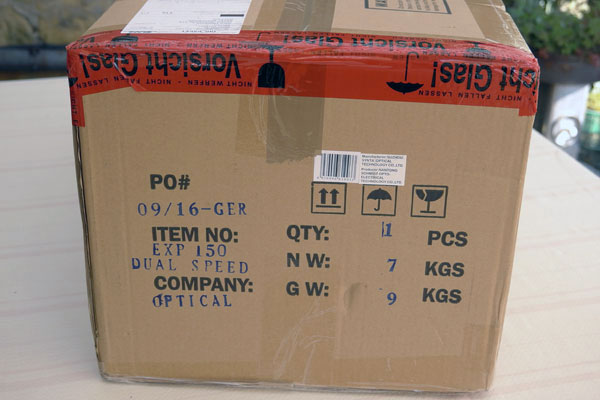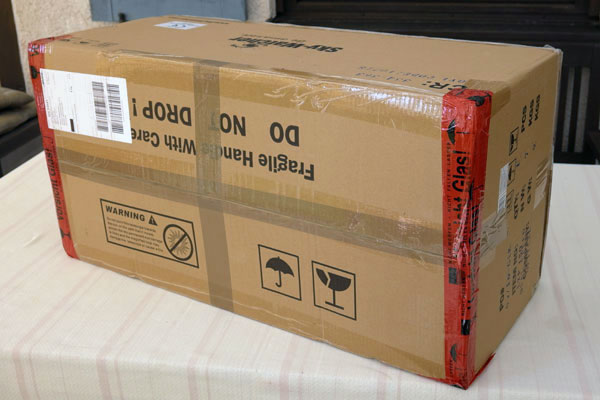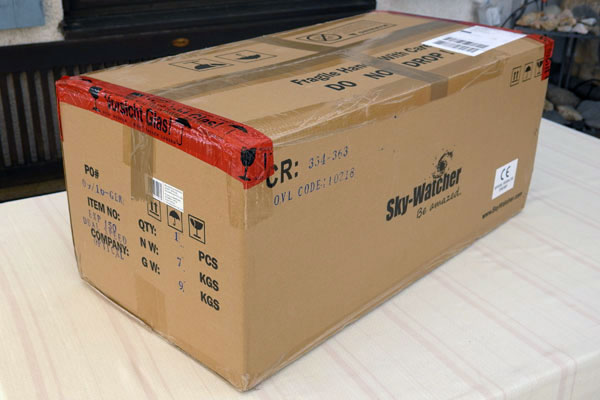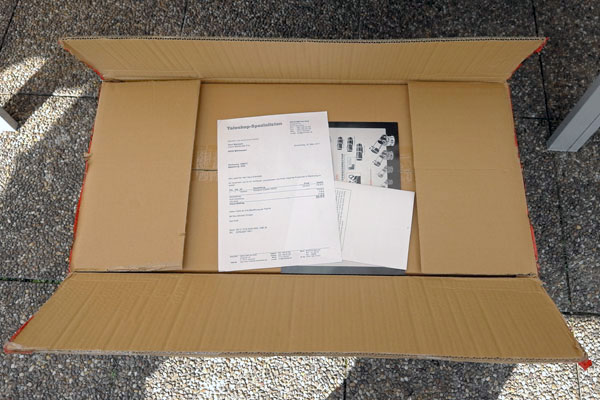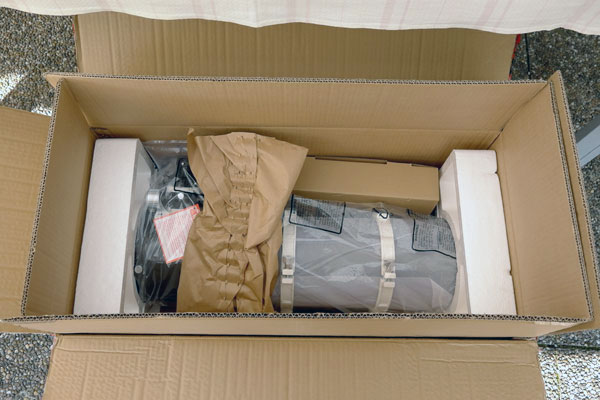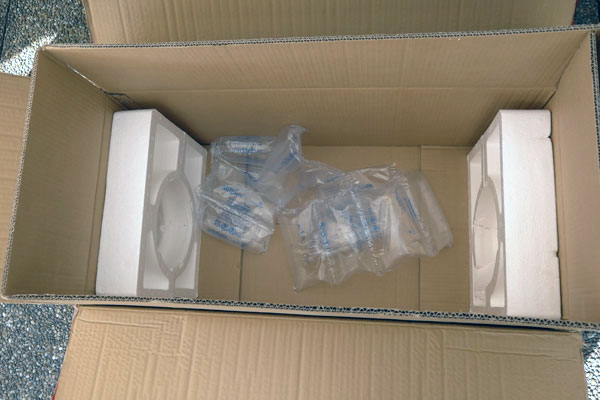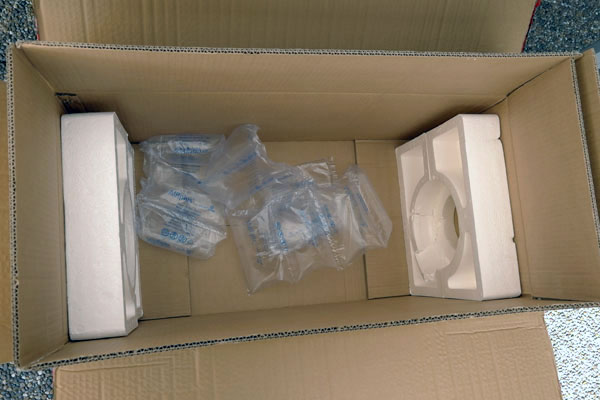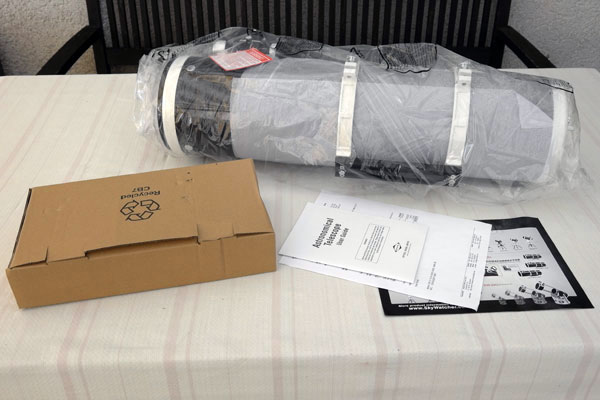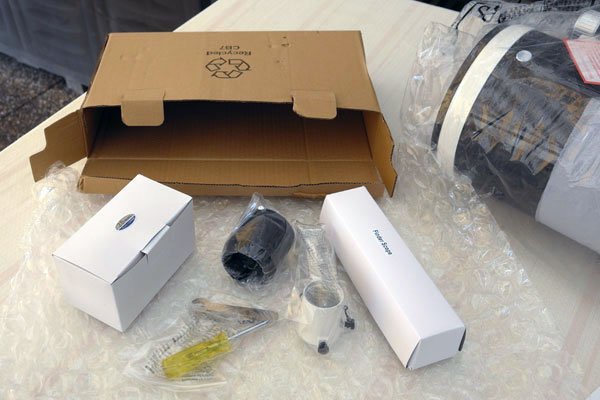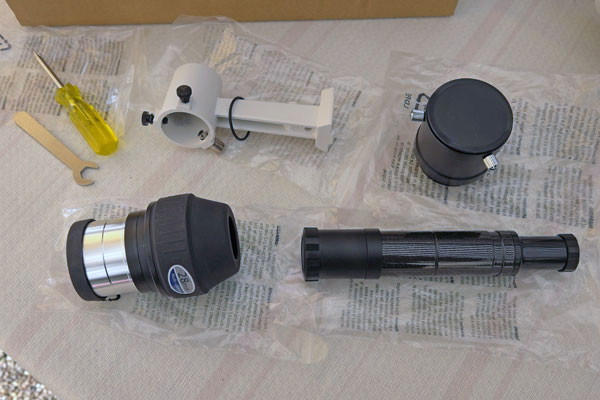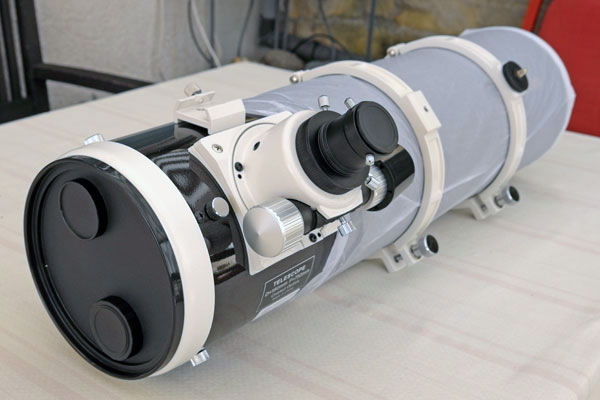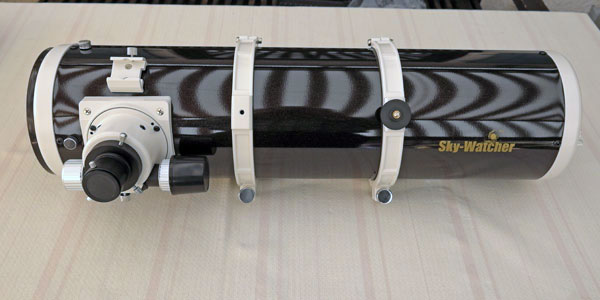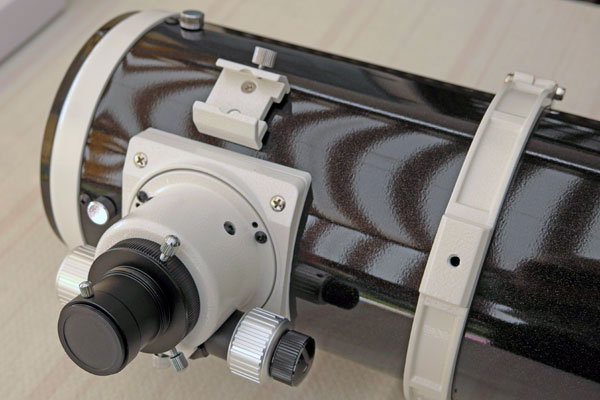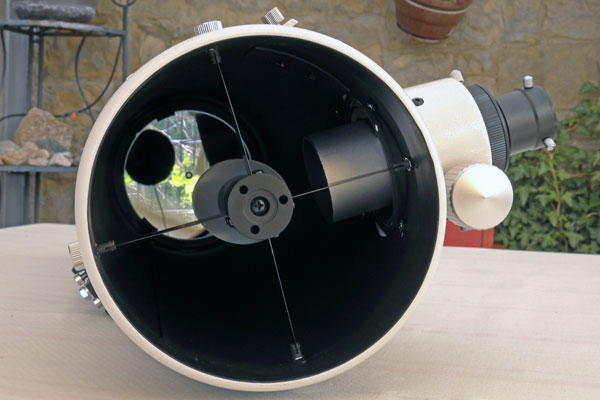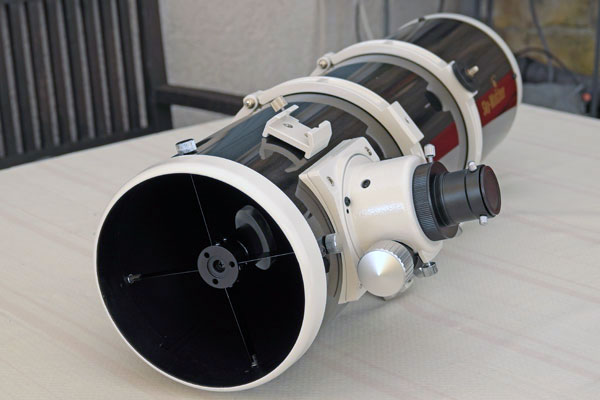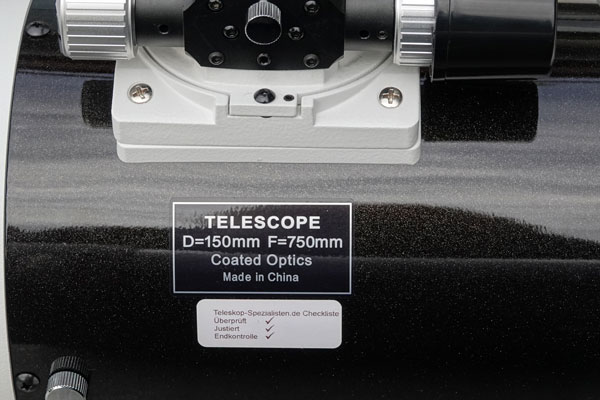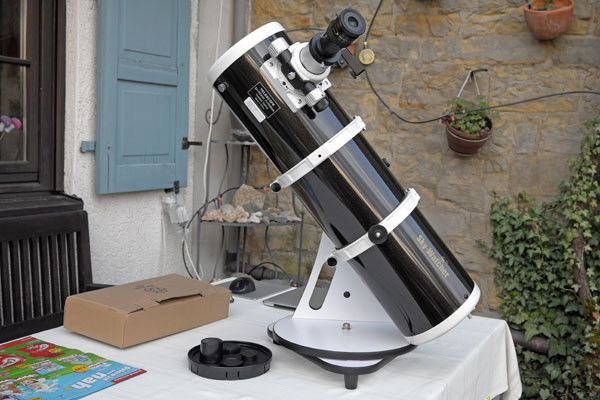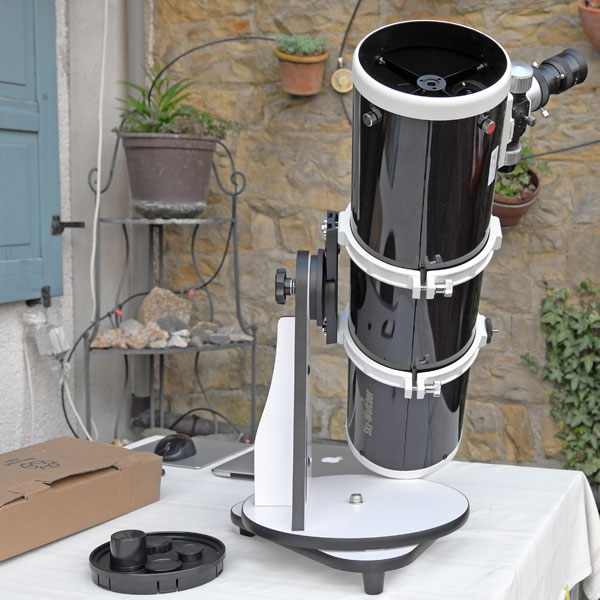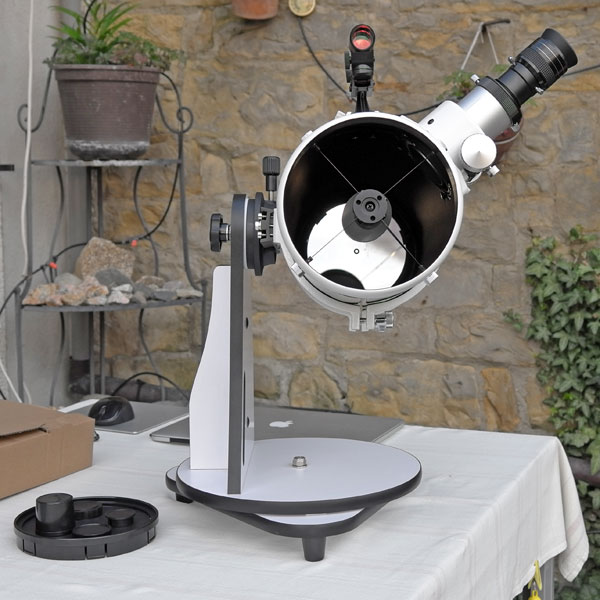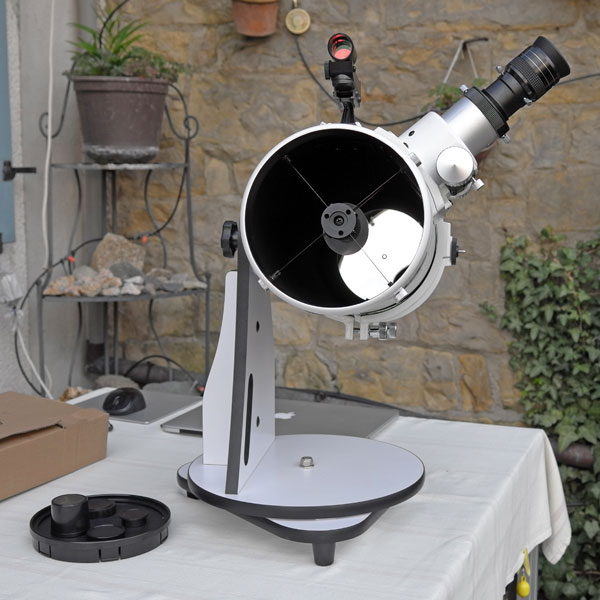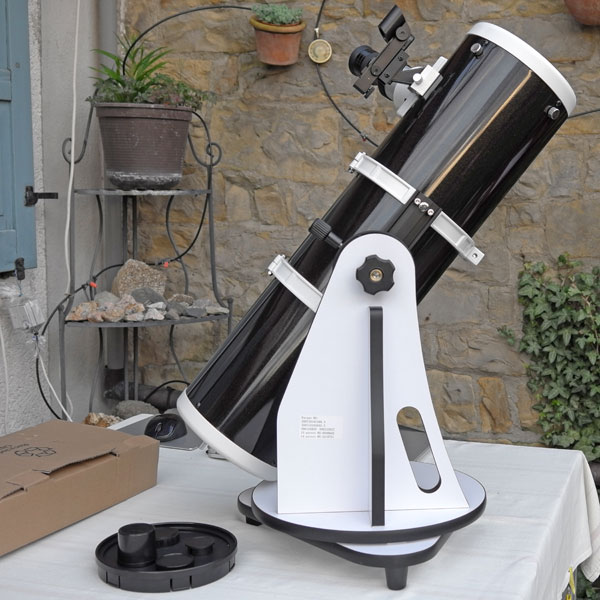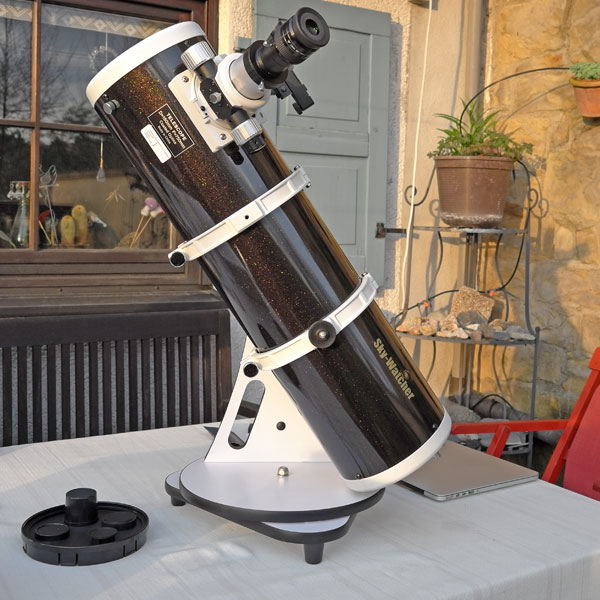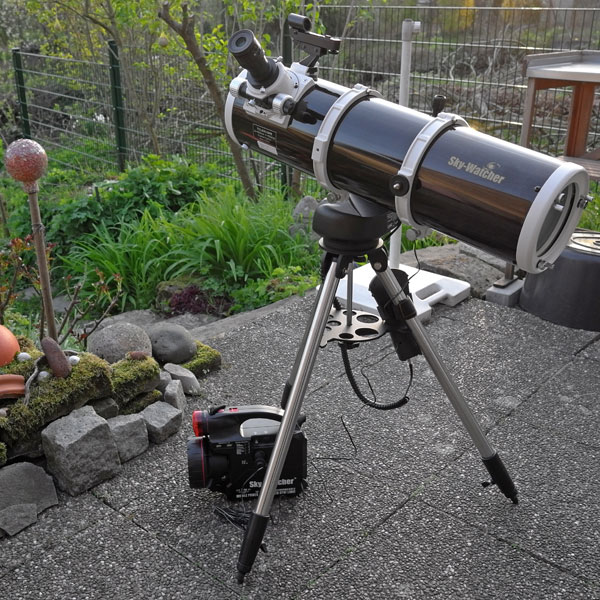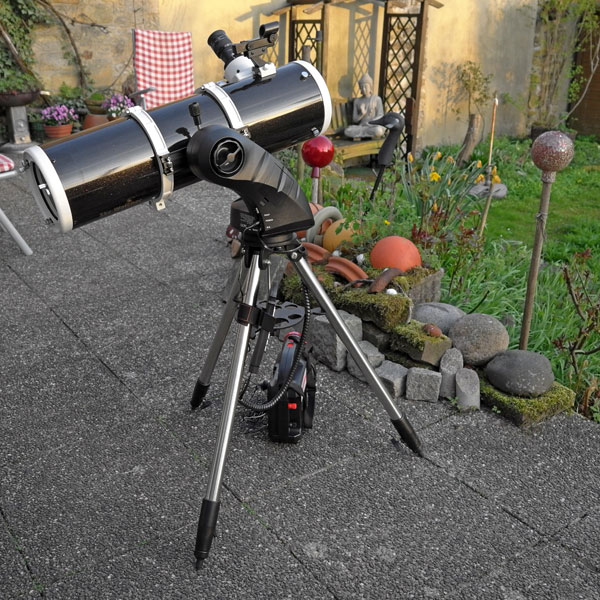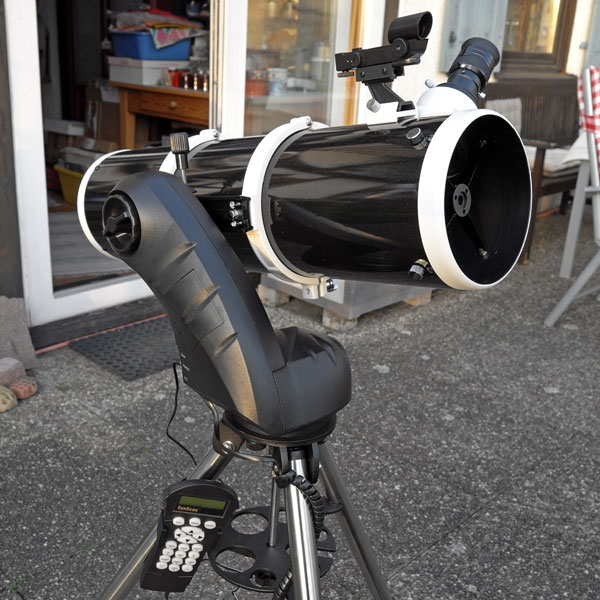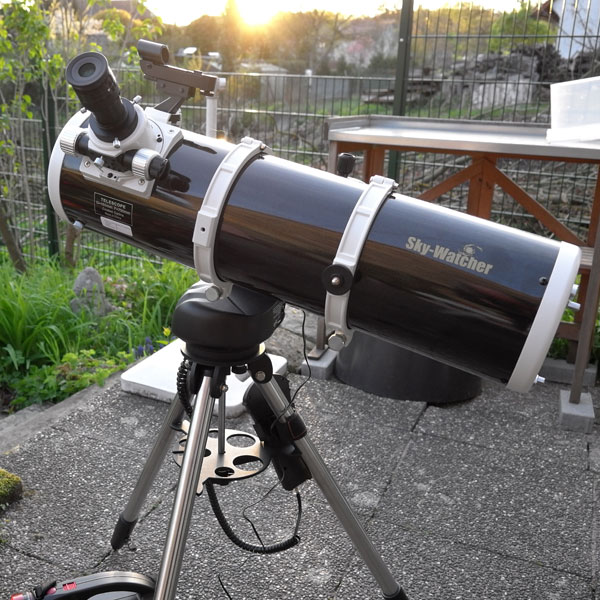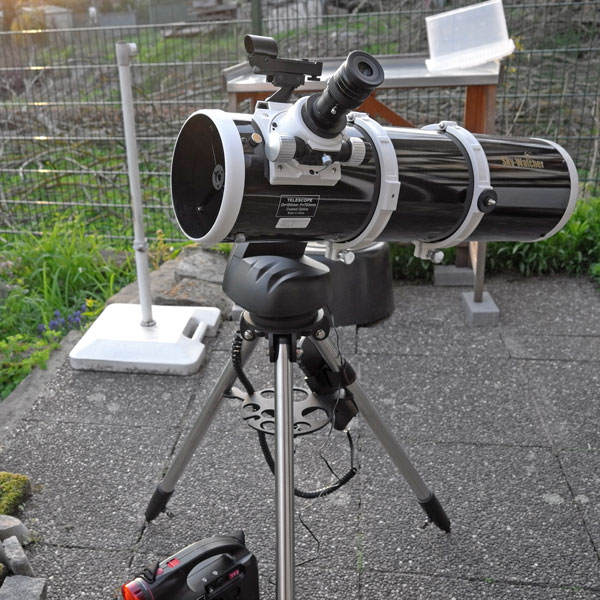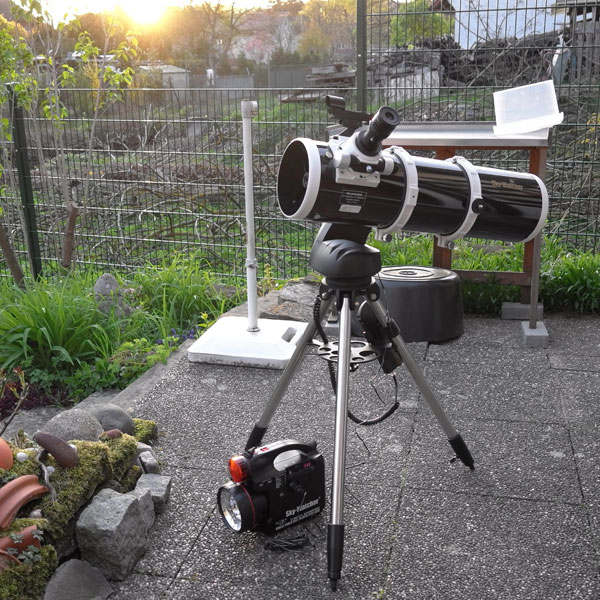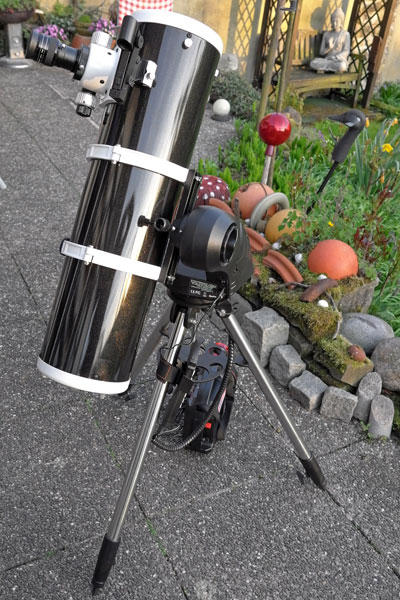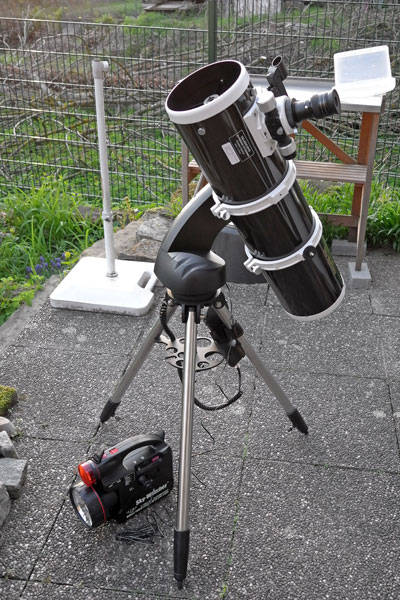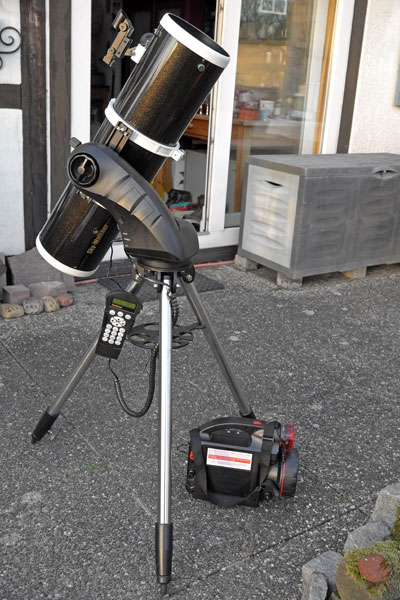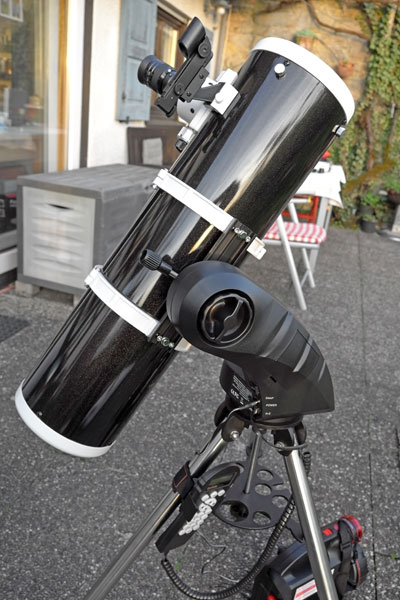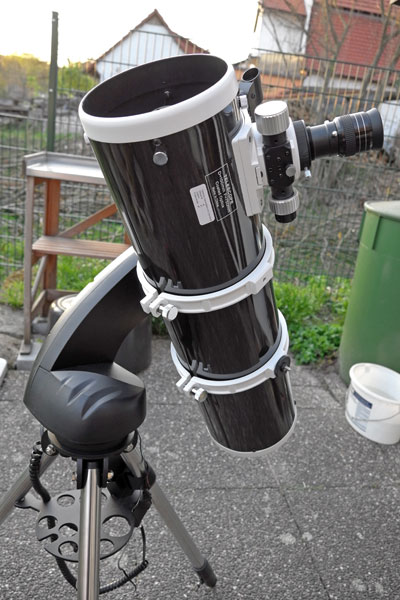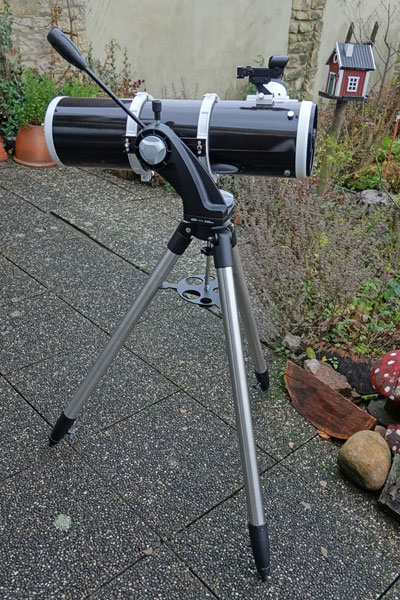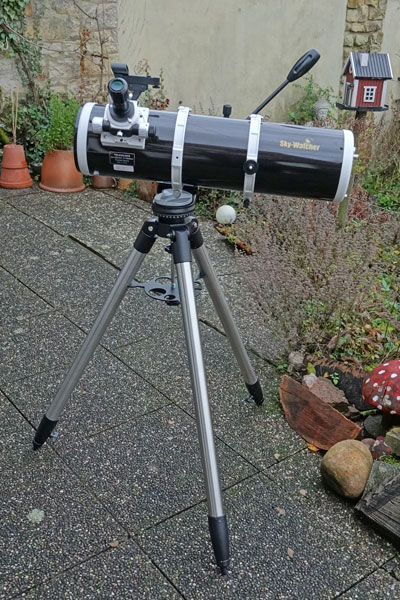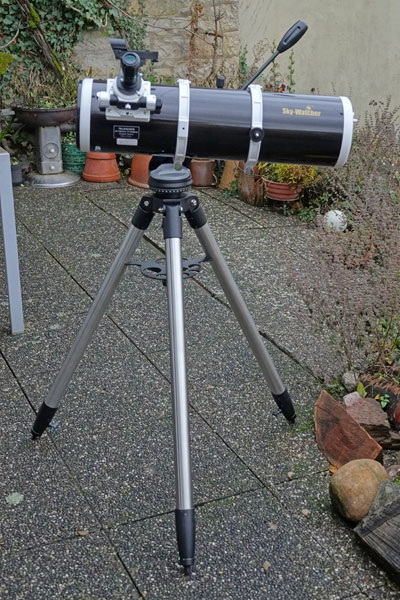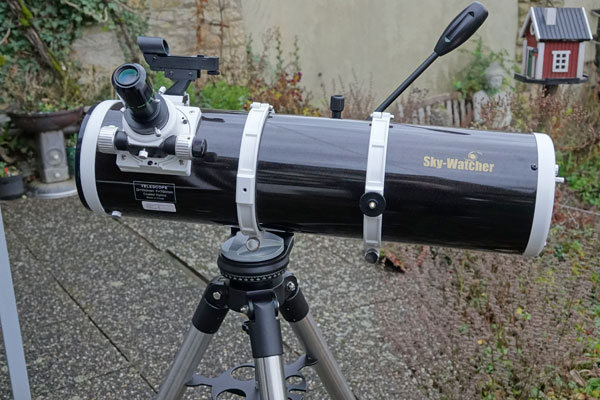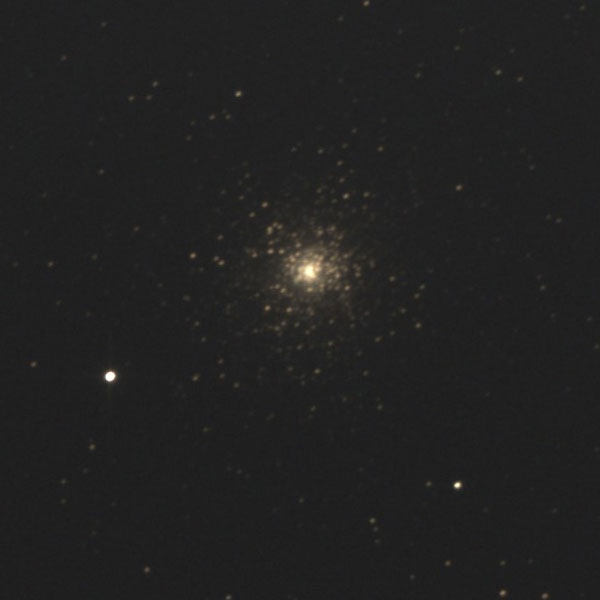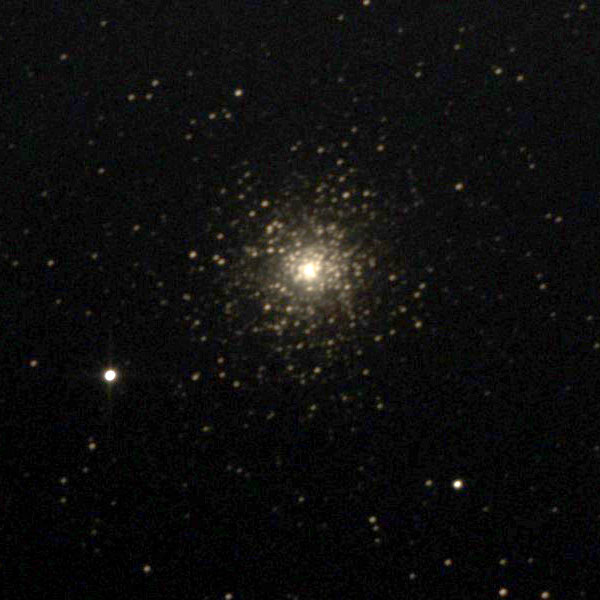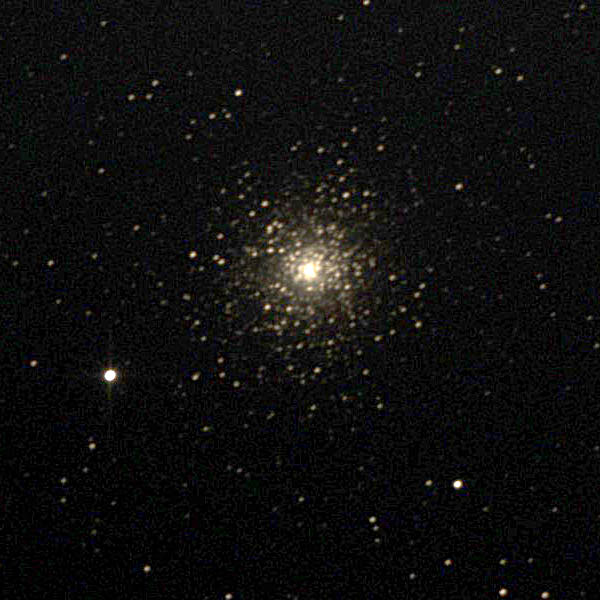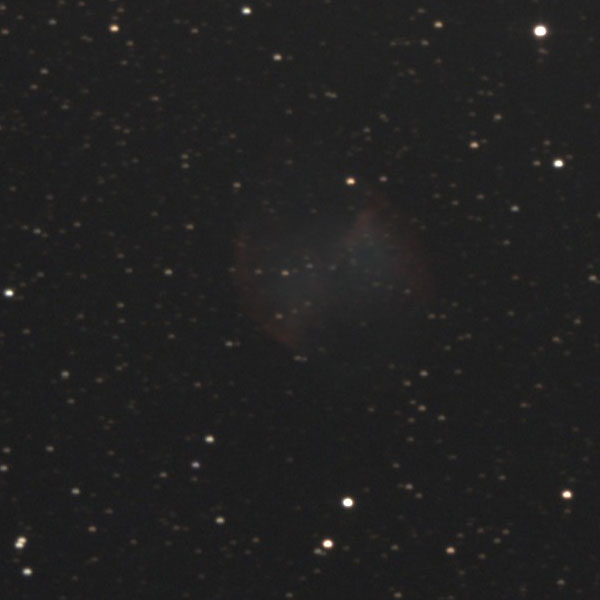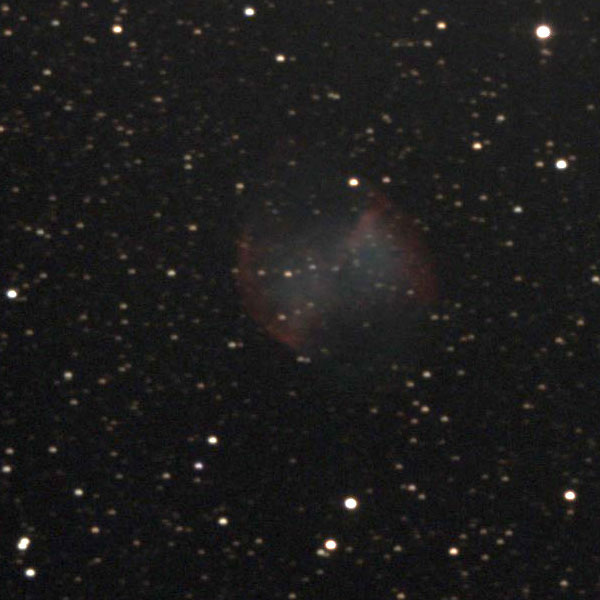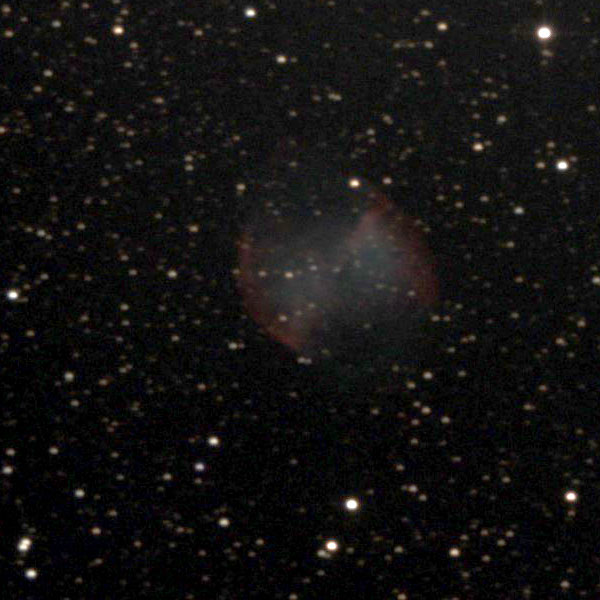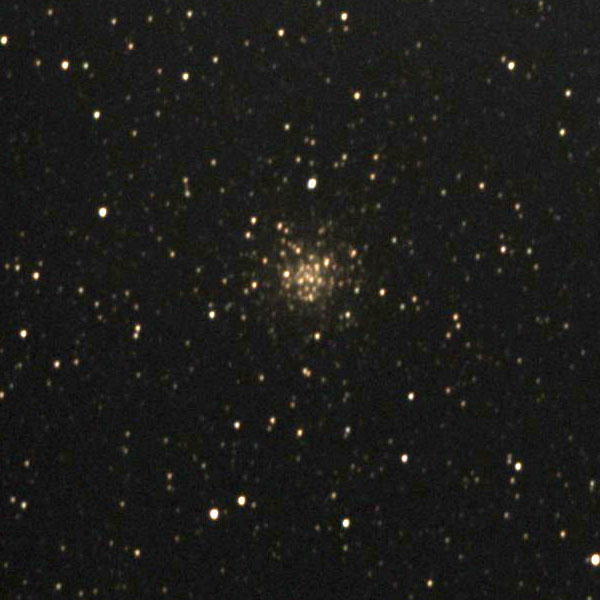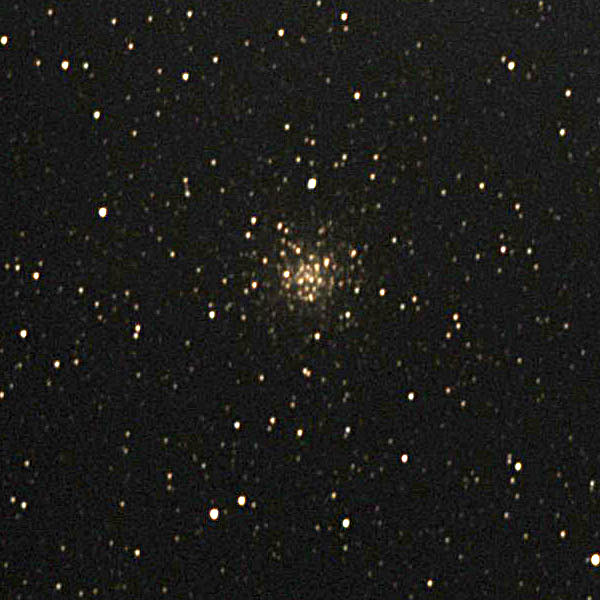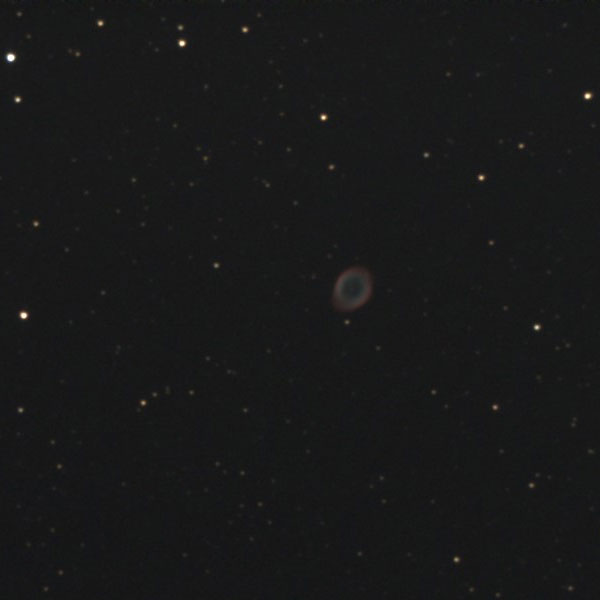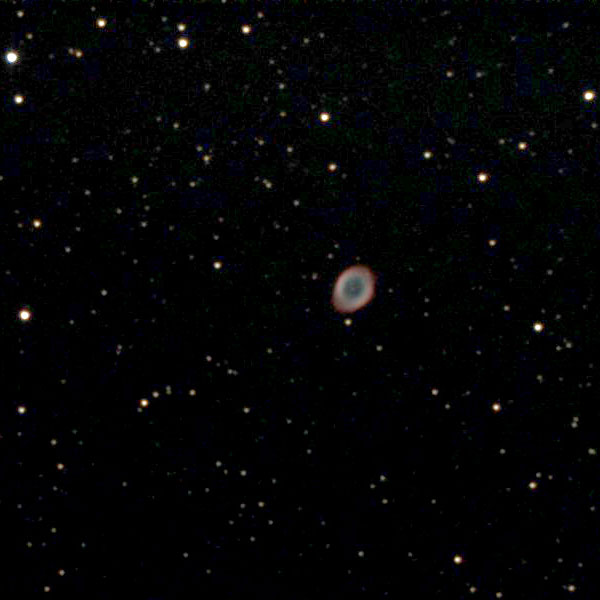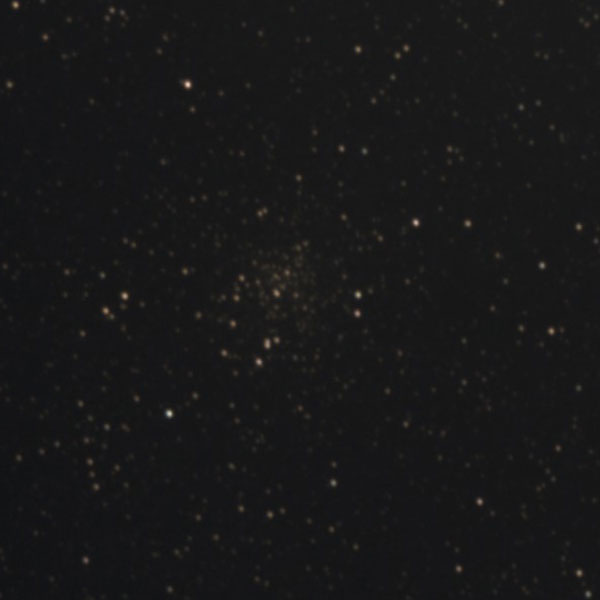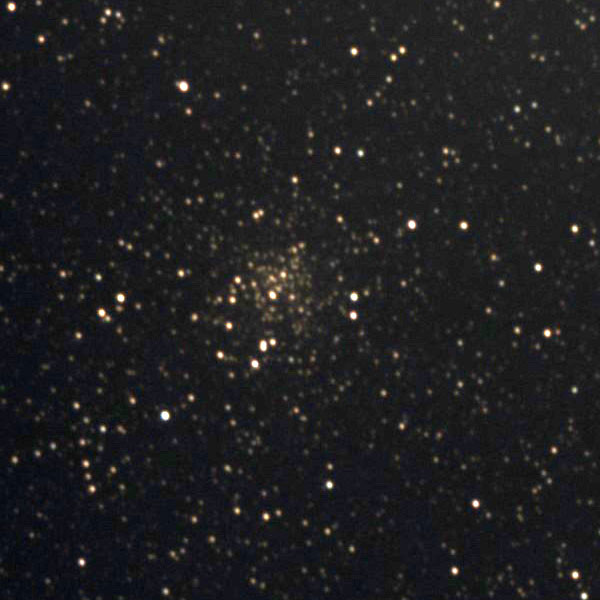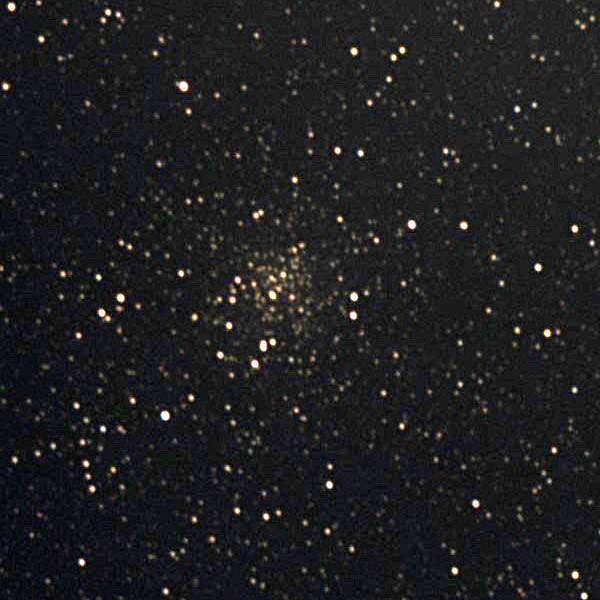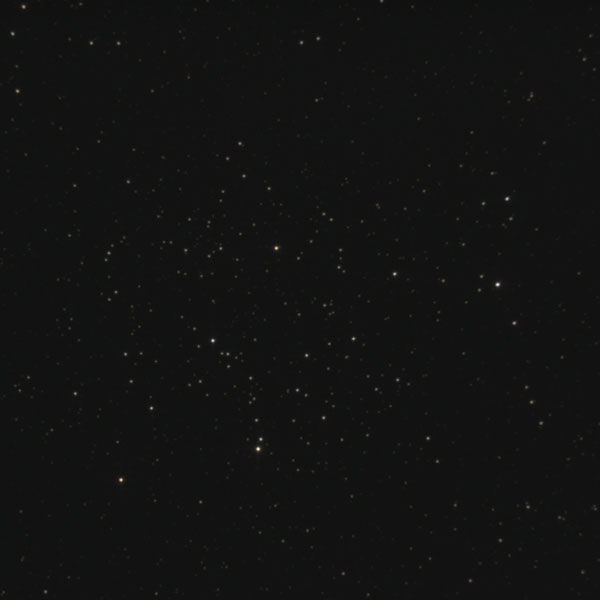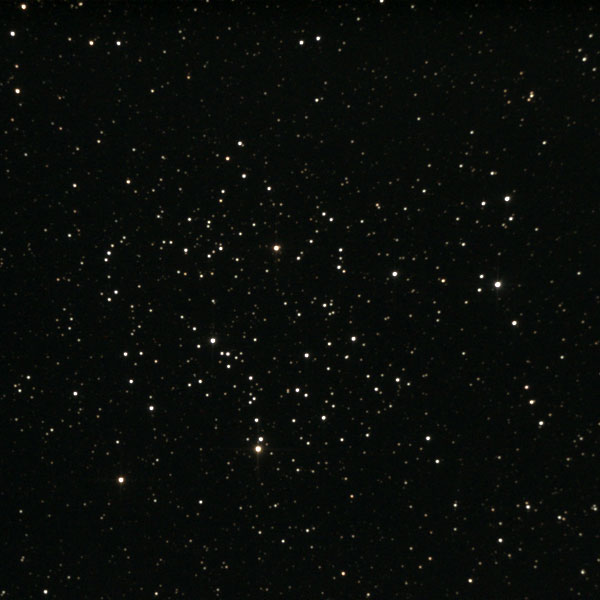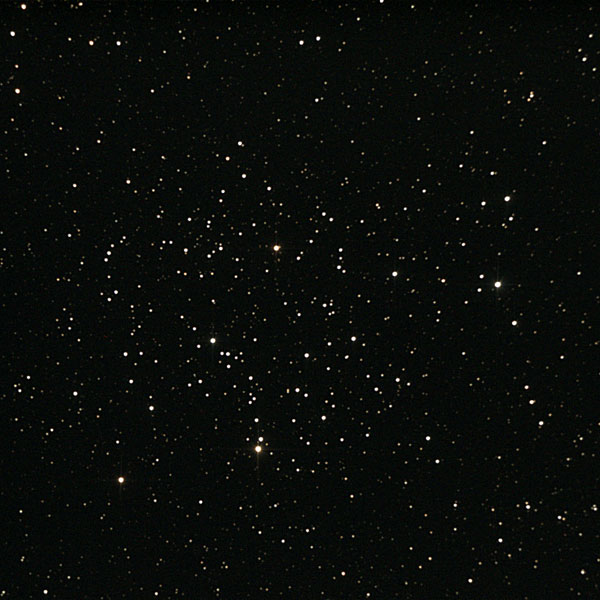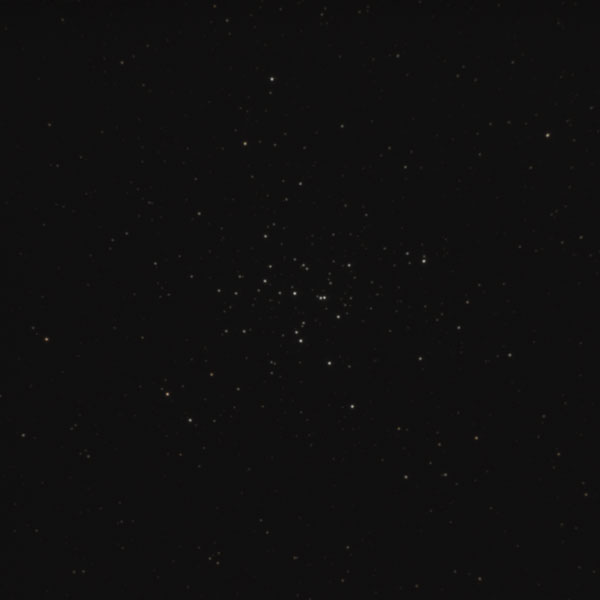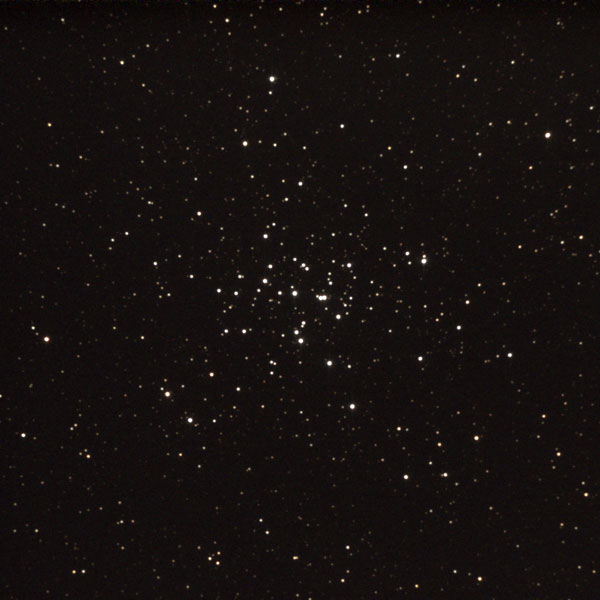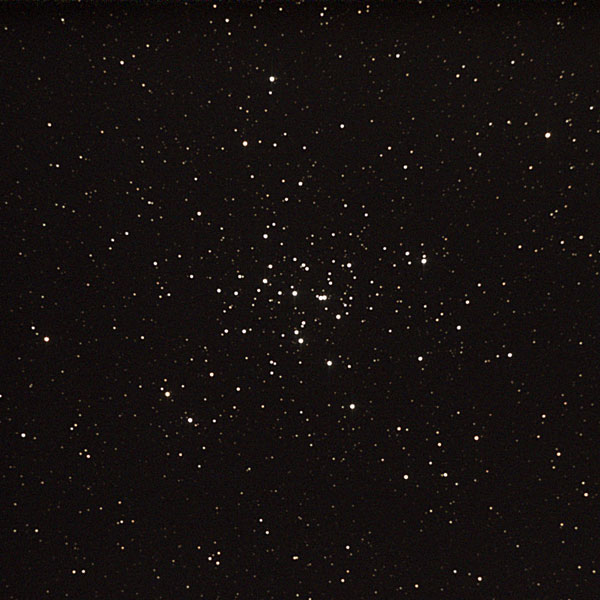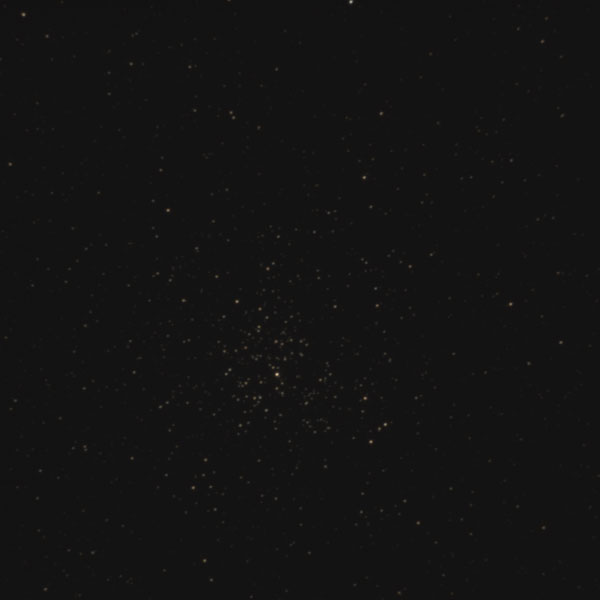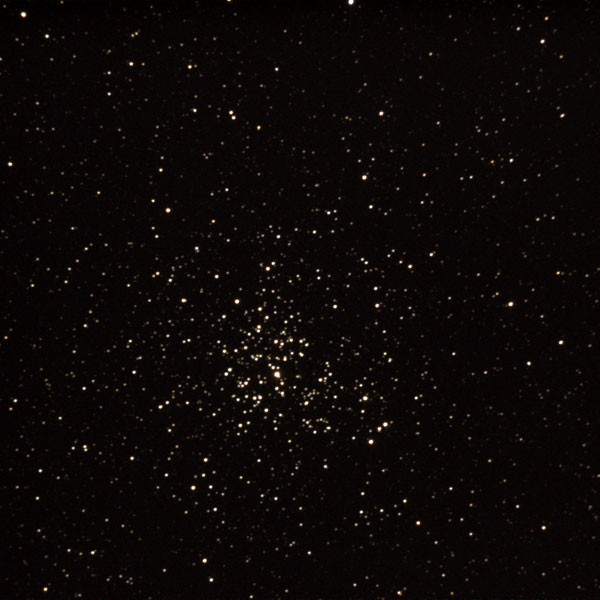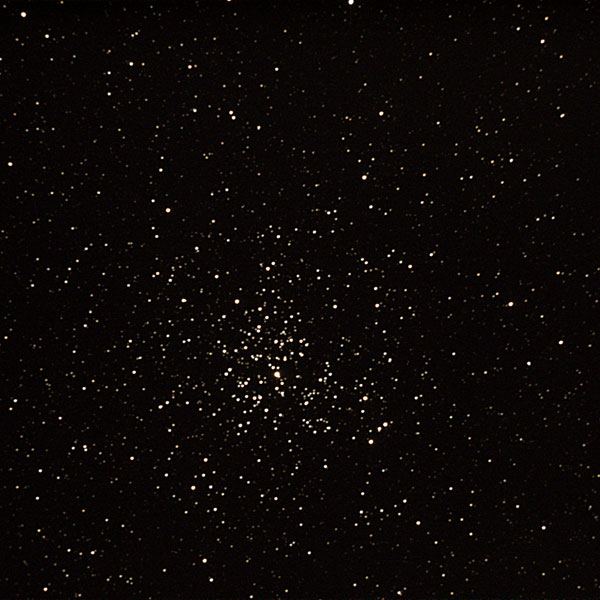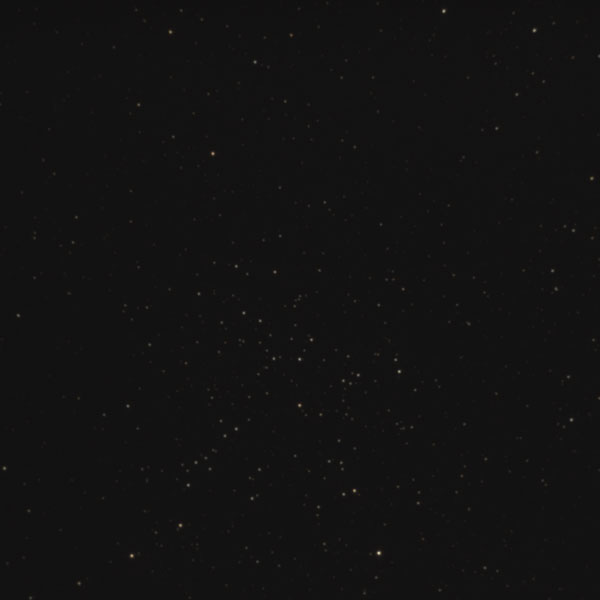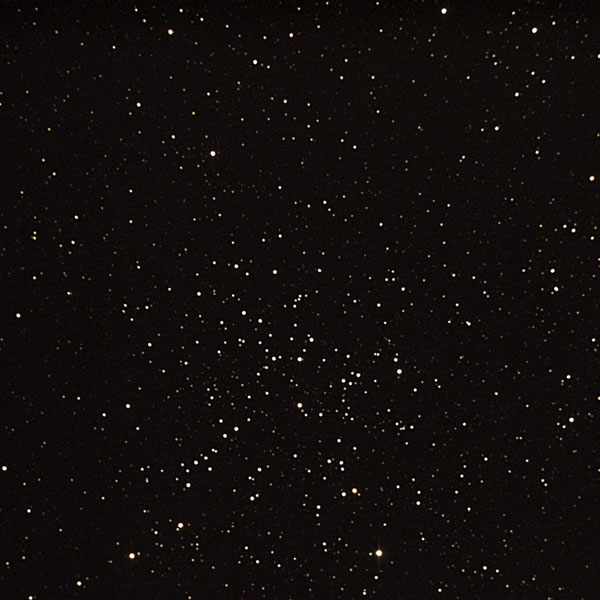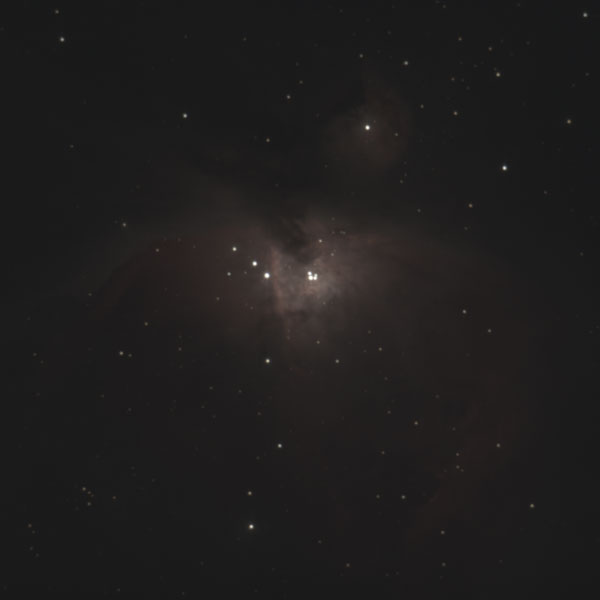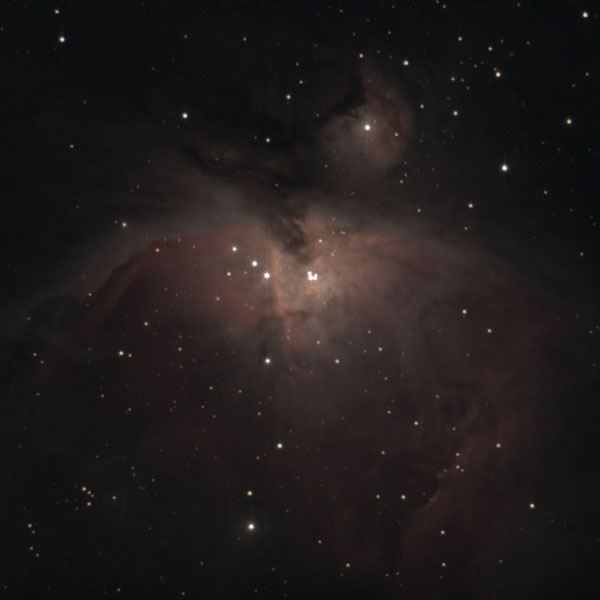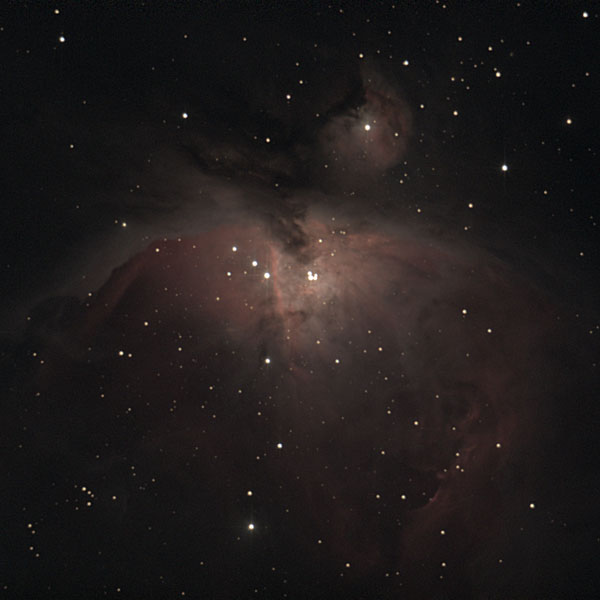Sky-Watcher Explorer 150PDS Information (6" Newton)
Motivation | Look | Visited Sky Objects | Photo Attempts | Experiences | Conclusions | Links | Appendix: Data | Appendix 2: Sky-Watcher Explorer 150PDS Report
Archive
On this page I provide some information about my 6" Sky-Watcher Explorer 150PDS Newtonian OTA (150 mm/750 mm, f/5; purchased at the beginning of April 2017). By the way, "PDS" means "designed for Photography" and "Dual-Speed 10:1 ratio focuser."
See the appendix for the data.
About the Mount...
At the beginning, I used the Sky-Watcher Explorer 150PDS OTA on the Dobsonian
base of the Sky-Watcher Heritage P130, although this combination was a bit
shaky and wobbly. Since I no longer own the P130, I now use the 150PDS only
on the Sky-Watcher
Star Discovery AZ GoTo mount. This mount can carry a maximum load
of 5 kg (the identical Orion StarSeeker IV mount is advertised as being able
to carry a maximum load of 6 kg). The 6" tube was advertised at online
dealers as weighing about 5 kg. After the purchase,
however, I found a tube weight of even 6 kg on the Sky-Watcher Website. My
own measurements revealed a weight of about 5.5 kg - plus viewfinder and eyepiece.
The whole affair definitely seemed to be a borderline case...
See here my experiences that I made so far with "overloading the mount with a 6" Newton tube."
Note: This problem no longer does exist for me, because I sold my Explorer 150PDS OTA in mid-January 2020.
In December 2019, I also bought a manual Sky-Watcher AZ4 mount, which allowed me to use the Explorer 150PDS purely manually (sold in May 2021).
| Note: I bought a Celestron C8 tube in November 2019, because I wanted to have an 8" tube, that is, more aperture. I therefore sold my 6" Sky-Watcher Explorer-150PDS Newtonian tube in mid-January 2020. I therefore can no longer report any further experiences with this scope here. |
Motivation
Why did I buy the Sky-Watcher Explorer 150PDS tube and for what purpose? I bought this tube as a replacement for my 8" Dobsonian telescope GSO GSD 680, which is a very fine telescope but became too heavy for me. I therefore replaced the GSD680 with the Explorer 150PS tube and sold it later.
Thus, the Explorer 150PDS is currently the terminal station on a longer journey from 10" via 8" to finally a modest 6" aperture! Usually, however, such journeys go in the opposite direction, that is, in the direction of larger apertures...
When buying the 6" tube, I also hoped that it can be used on the Sky-Watcher Star Discovery AZ GoTo mount as the maximum possible option. Thus, all my telescope tubes would then be also usable on my GoTo mount. As written above, this mount can carry a maximum load of 5 kg. My own measurements revealed a weight of about 5.5 kg - plus viewfinder and eyepiece. I will see, whether this will indeed work in the long run.
Since there was only a small gap between the Explorer 150PDS tube and the Heritage P130, I parted with the latter and gave it away to a friend in April 2017.
Look
Unpacking
|
Outer package |
Ditto |
Ditto |
|
Ditto |
Opened package |
Ditto |
|
Styrofoam |
Ditto |
One of the Styrofoam pieces was damaged... |
|
Package content |
Content of accessories box |
Ditto |
|
Accessories |
Tube with protective paper, oblique rear view |
Ditto, oblique front view |
|
Detail: Focuser with 1:10 dual speed transmission |
Looking into the tube |
Ditto, here you can see the mark on the primary mirror |
Accessories: 6 x 30 finder, 28 mm eyepiece (2"), 2" extension ring for visual observations, tools Box weights and size: NW = 7 kg, GW = 9 kg 80 cm x 39 cm x 34 cm |
Explorer PDS150 Newtonian Tube on Heritage P130 Rockerbox
Note: This was a solution for very quick observation only! It was wobbly and trembled; the tube did not reach the zenith either. |
Note: I do no longer own the Heritage P130 (and thus, its Dobsonian mount) |
Explorer PDS150 Newtonian Tube on Sky-Watcher Star Discovery AZ GoTo Mount
Explorer 150PDS Newtonian Tube on Sky-Watcher AZ4 Mount
Visited Sky Objects
So far, I have visited (and documented...) the following sky objects with the Sky-Watcher Explorer PDS150:
- Moon, Jupiter , Saturn
- Without GoTo (9.4.2017): M 35 and M 42/43
- With GoTo (May 2017): M 3, M 5, M 13, M 35, M 44, M 49, M 51, M 53, M 64, M 65/66, M 67, M 81/82, M 87, M 92, M 94, M 96, M 104, M 106
- With GoTo (May 2019): M 35, M 36, M 37, M 38, M 44
- With Atik Infinity (Beginning of 2018): M 15, M 27, M 35, M 36, M 37, M 38, M 42/43, M 56 , M 57, M 71
- With GoTo (August 2019): M 11, M 13, M 27, M 57, M 92
- Without Goto (October 2019-January 2020): M 11, M 15, M 35, M 42/43, M 45, M 78, Mel 25
Highlights
- Moon (Photos of the Moon April 2017, Photos of the Moon May 2017, Photos of the Moon March 2018)
- Planets: Jupiter (with moons), Saturn (with ring)
- DSO (globular cluster): M 3, M 5, M 13, M 15
- DSO (star cluster): M 11, M 35, M 44, M 45
- DSO (nebulae): M 27, M 42/43, M 57
Photo Attempts
First Moon Photos with the Camera Held to the Eyepiece
The following photos of the moon were taken at the beginning of April 2017 (April 1, 2, and 3; on April 3, it was half moon). They were taken using the 1:50 method, that is, with the camera held to the eyepiece. In this case, I used my Ricoh GR (28 mm equivalent) at ISO 1600 and underexposed to avoid flare.
I used a 16 mm and a 7 mm UWA eyepiece. With the latter, I was able to see the full moon, but not to "catch" it.
April 1, 2017 |
||
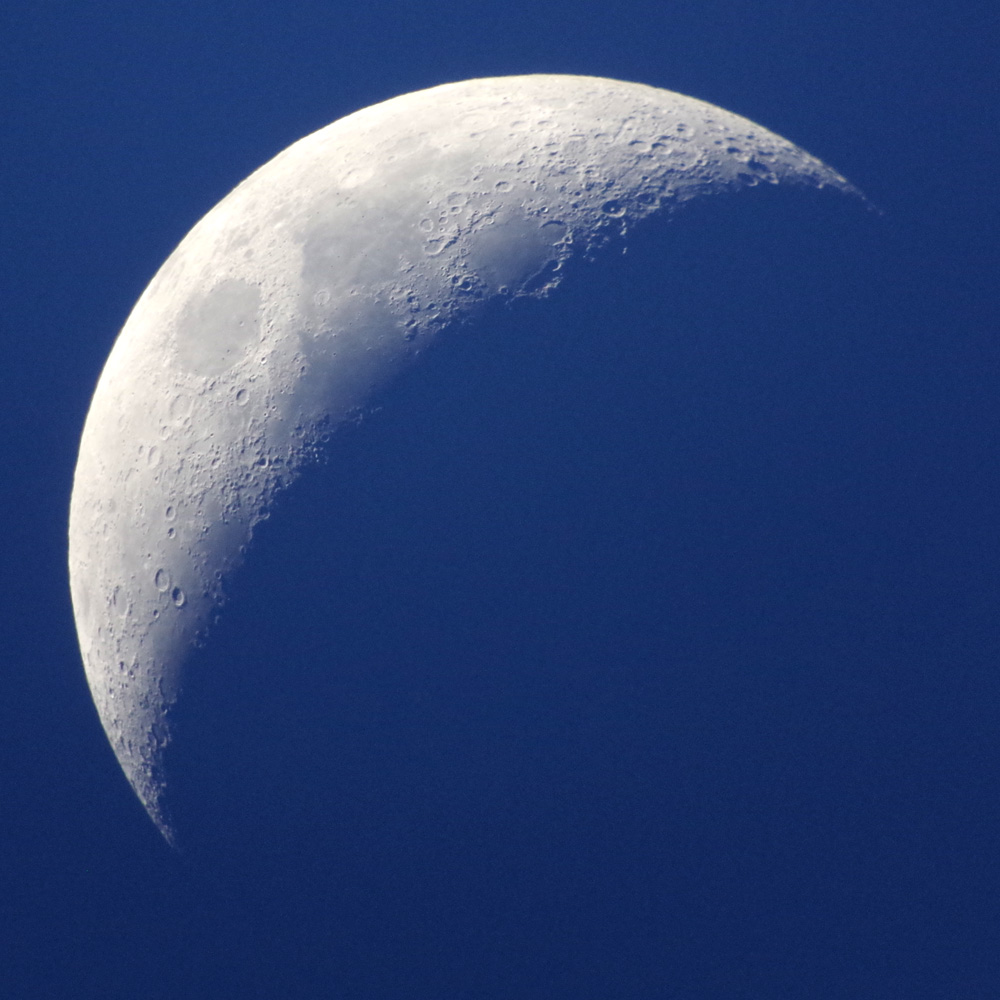 |
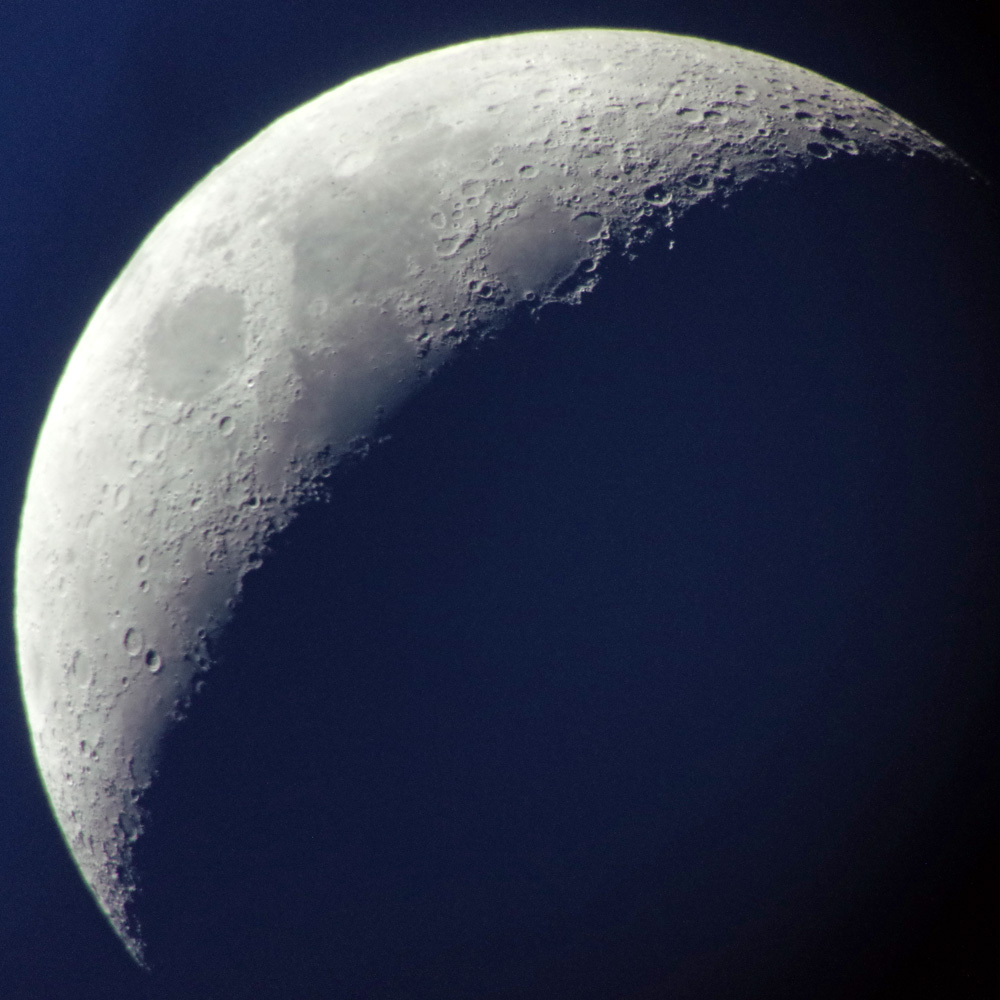 |
|
16 mm eyepiece (approx. 47 x) - 2000 pixels version |
|
7 mm eyepiece (approx. 107 x) - 2000 pixels - 3200 pixels |
 |
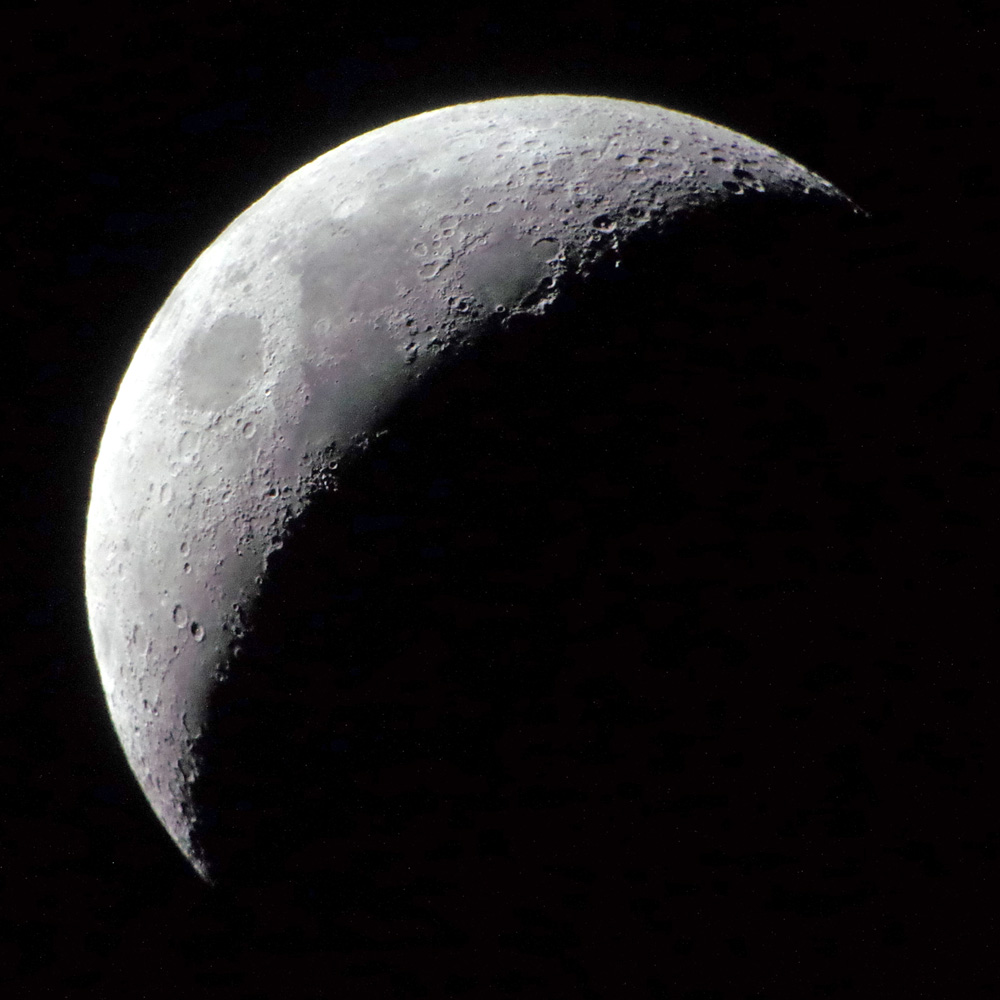 |
|
16 mm eyepiece (approx. 47 x) - 2000 pixels version |
16 mm eyepiece (approx. 47 x) - 2000 pixels version |
|
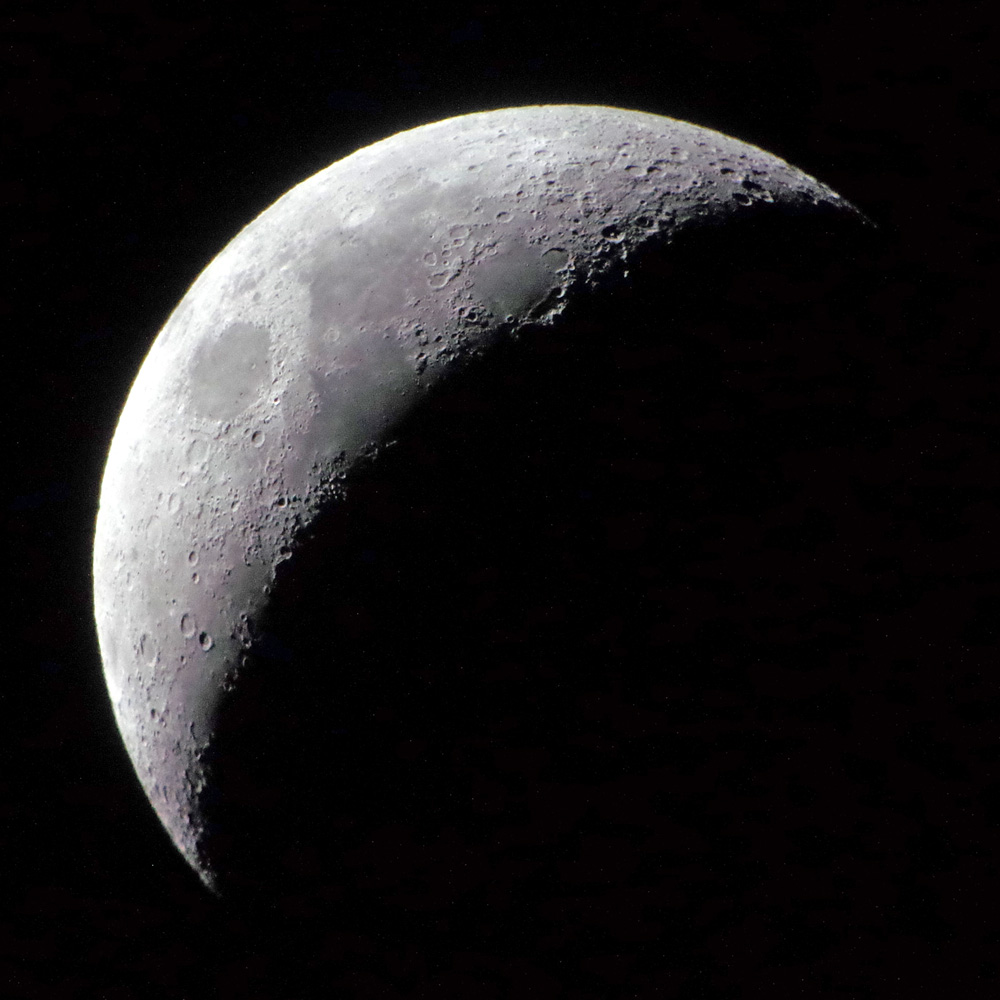 |
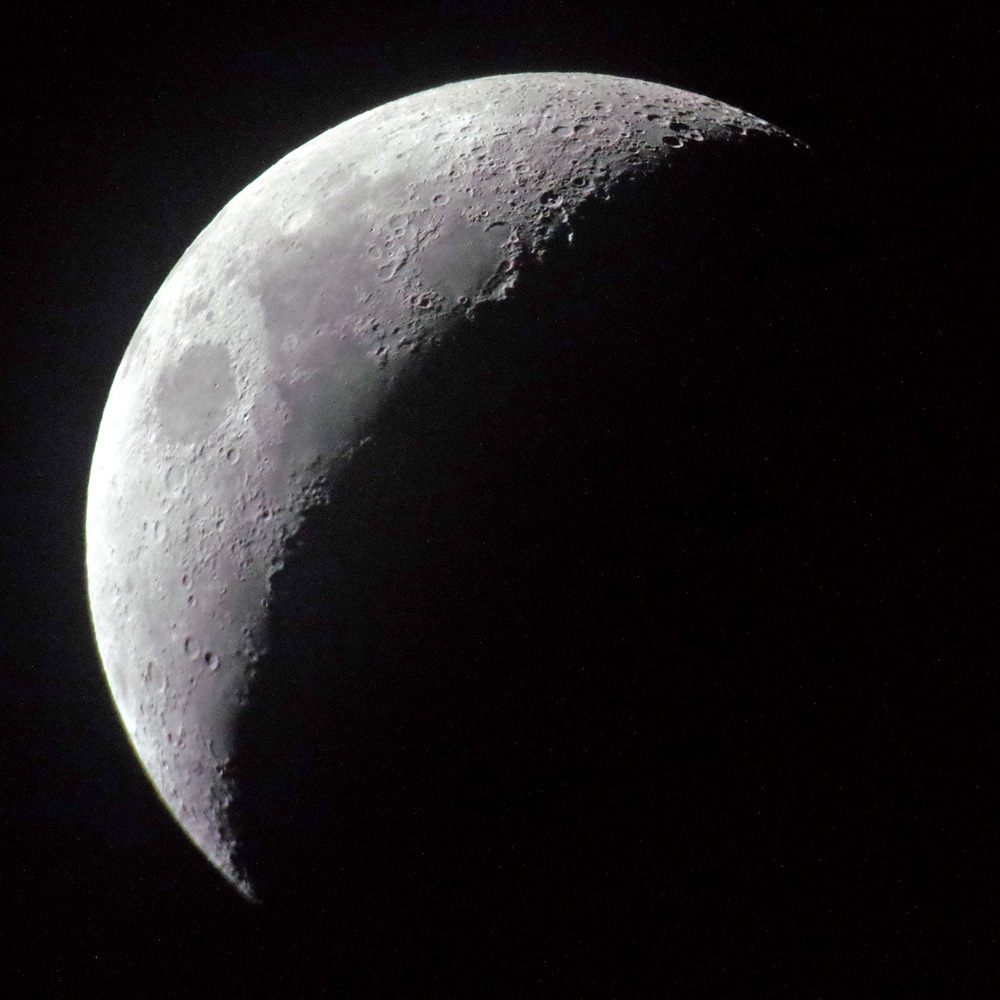 |
|
16 mm eyepiece (approx. 47 x) - 2000 pixels version |
16 mm eyepiece (approx. 47 x) - 2000 pixels version |
|
April 2, 2017 |
||
 |
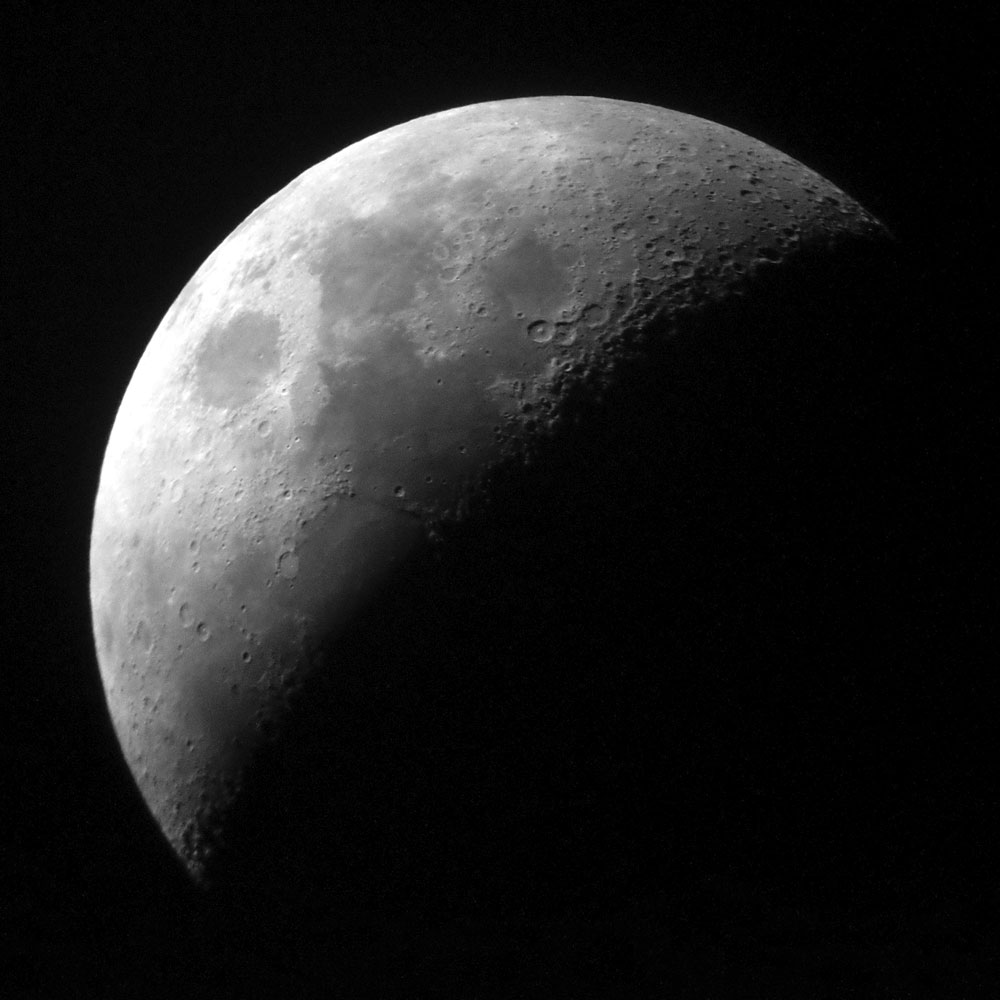 |
|
7 mm eyepiece (approx. 107 x) - 2000 pixels version - SW |
16 mm eyepiece (approx. 47 x) - 2000 pixels version - SW |
|
April 3, 2017 (Half Moon) |
||
 |
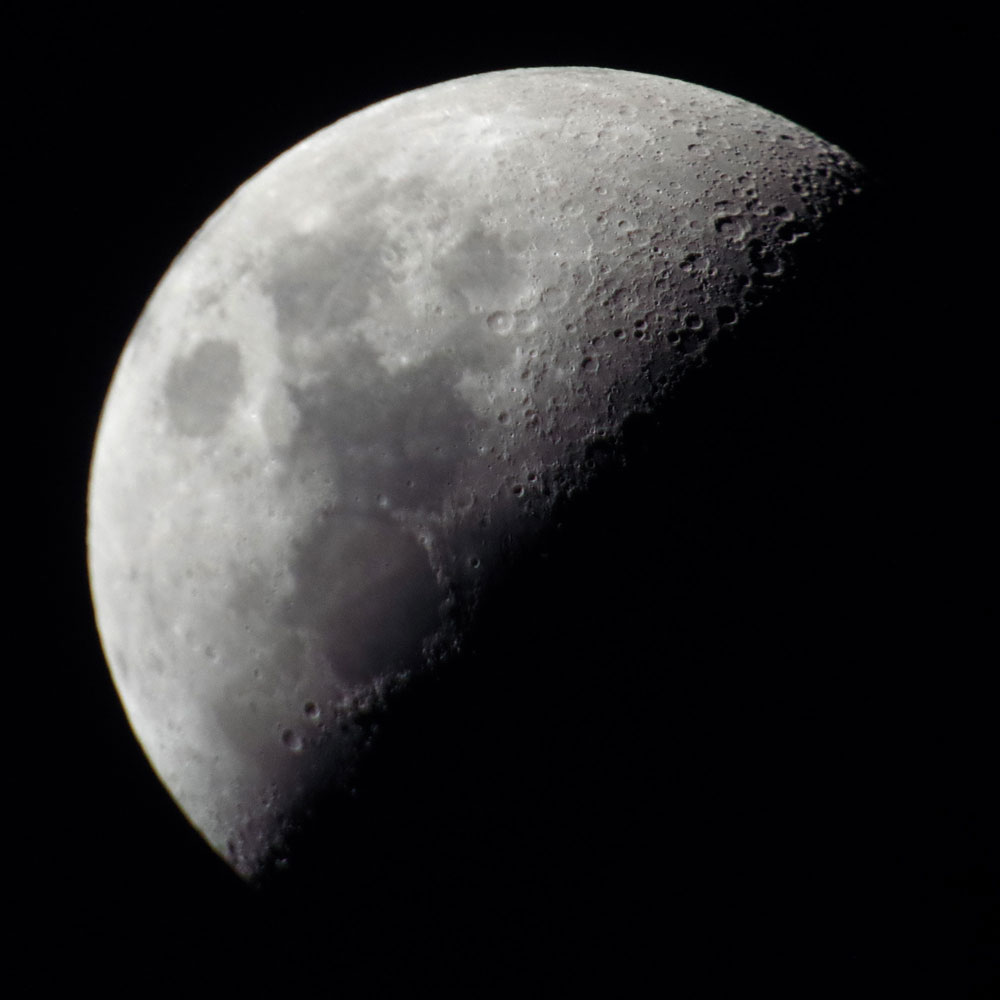 |
|
16 mm eyepiece (approx. 47 x) - 2000 pixels version |
16 mm eyepiece (approx. 47 x) - 2000 pixels version |
|
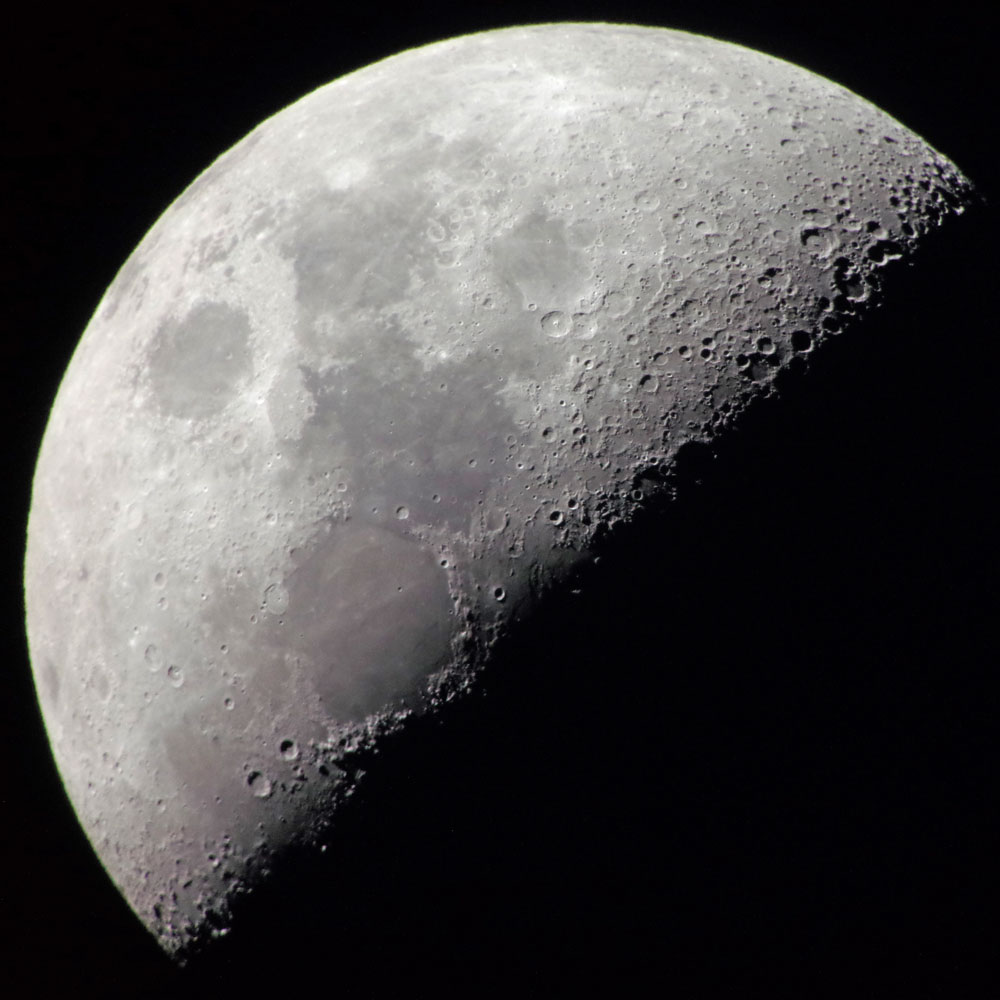 |
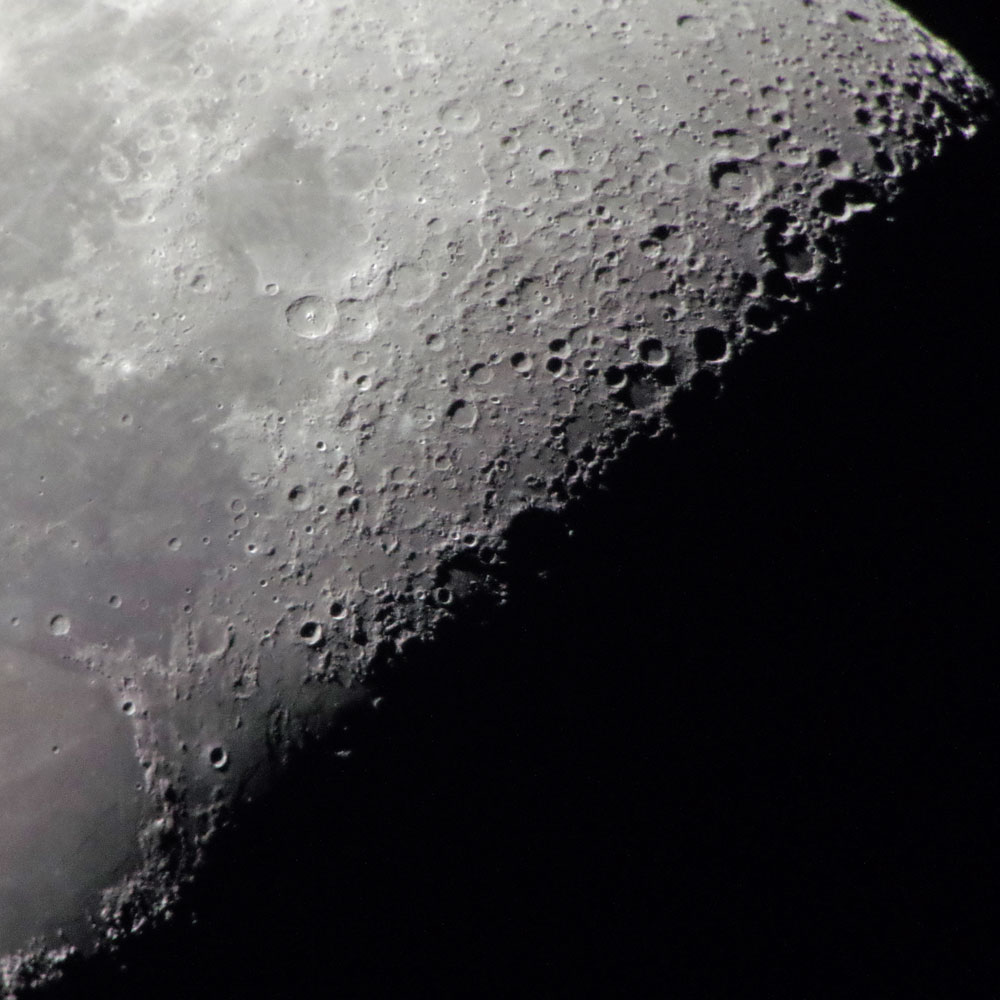 |
|
7 mm eyepiece (approx. 107 x) - 2000 pixels - 3200 pixels |
7 mm eyepiece, section (approx. 107 x) - 2000 pixels version |
|
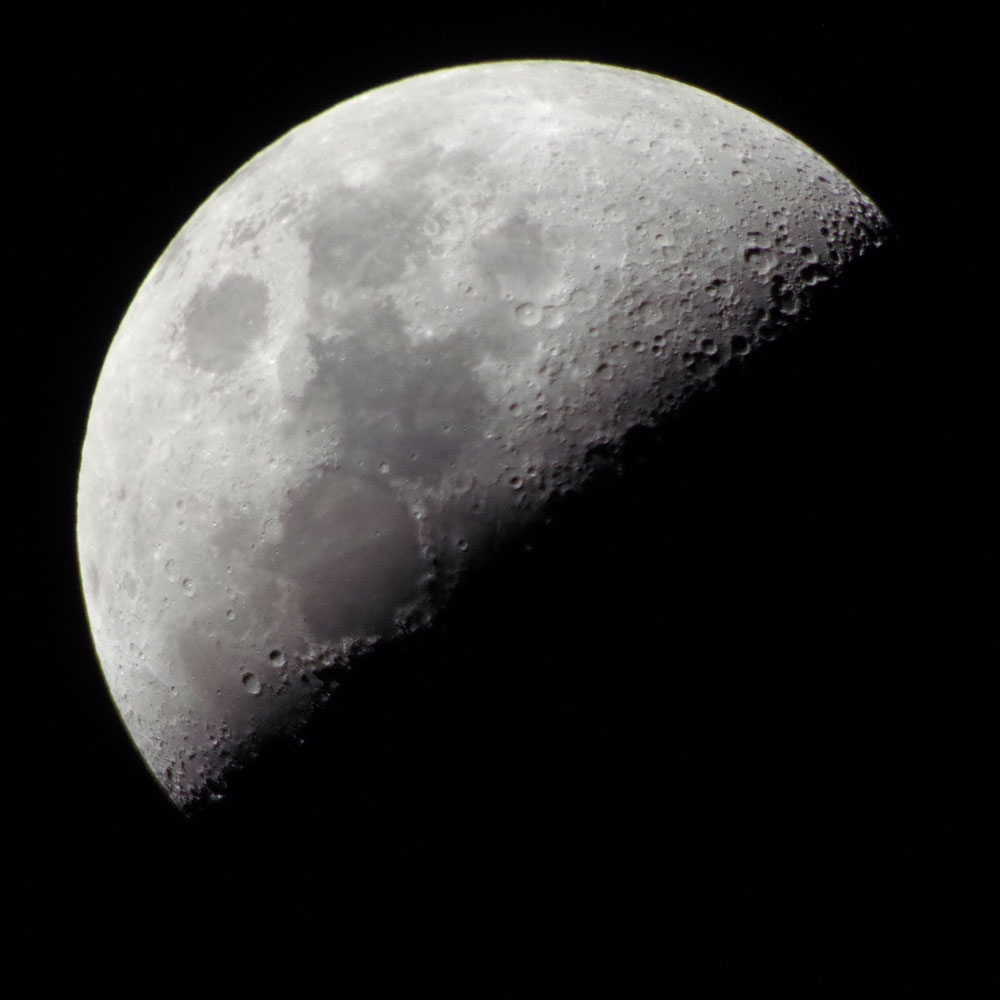 |
 |
|
16 mm eyepiece (approx. 47 x) - 2000 pixels version |
16 mm eyepiece (approx. 47 x) - 2000 pixels version |
|
Comparison of the Days |
||||
 |
 |
 |
||
April 1, 2017 |
April 2, 2017 |
April 3, 2017 (half moon) | ||
April 6, 2017 |
||
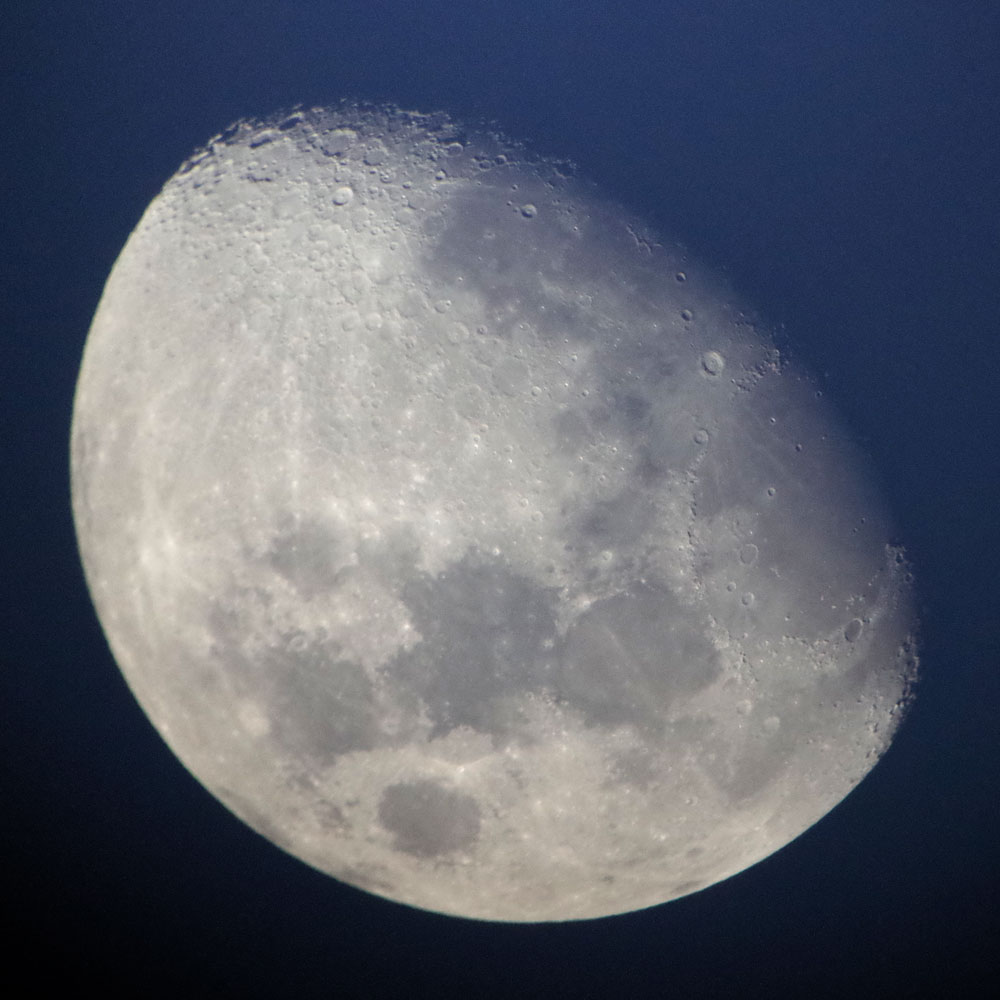 |
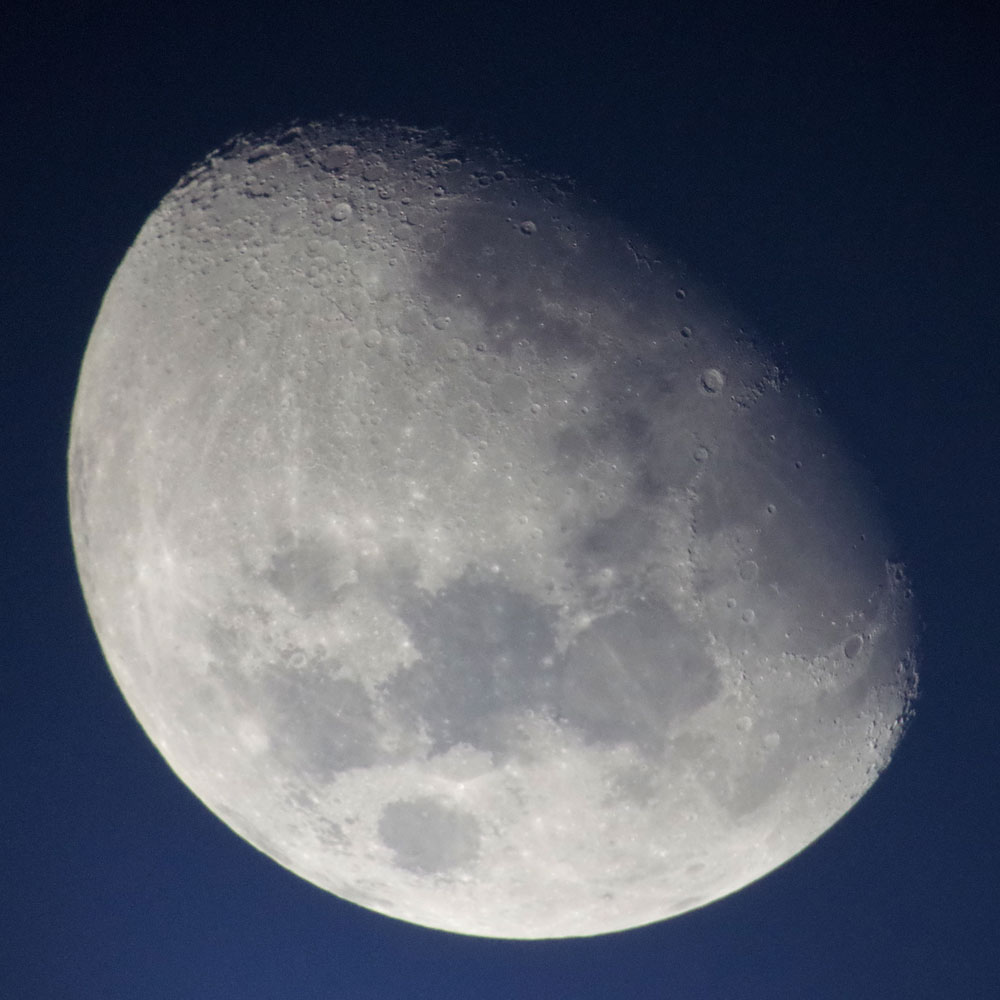 |
|
16 mm eyepiece (approx. 47 x) - 2000 pixels version |
|
16 mm eyepiece (approx. 107 x) - 2000 pixels |
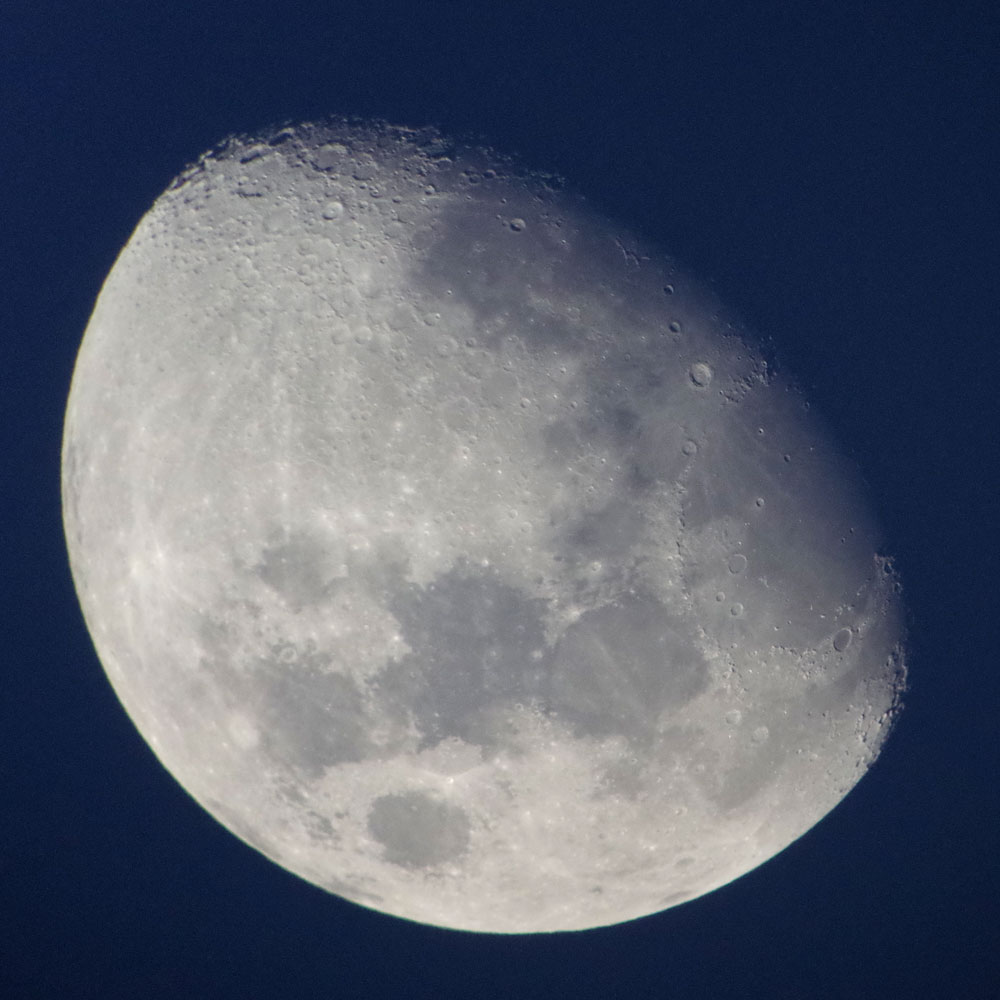 |
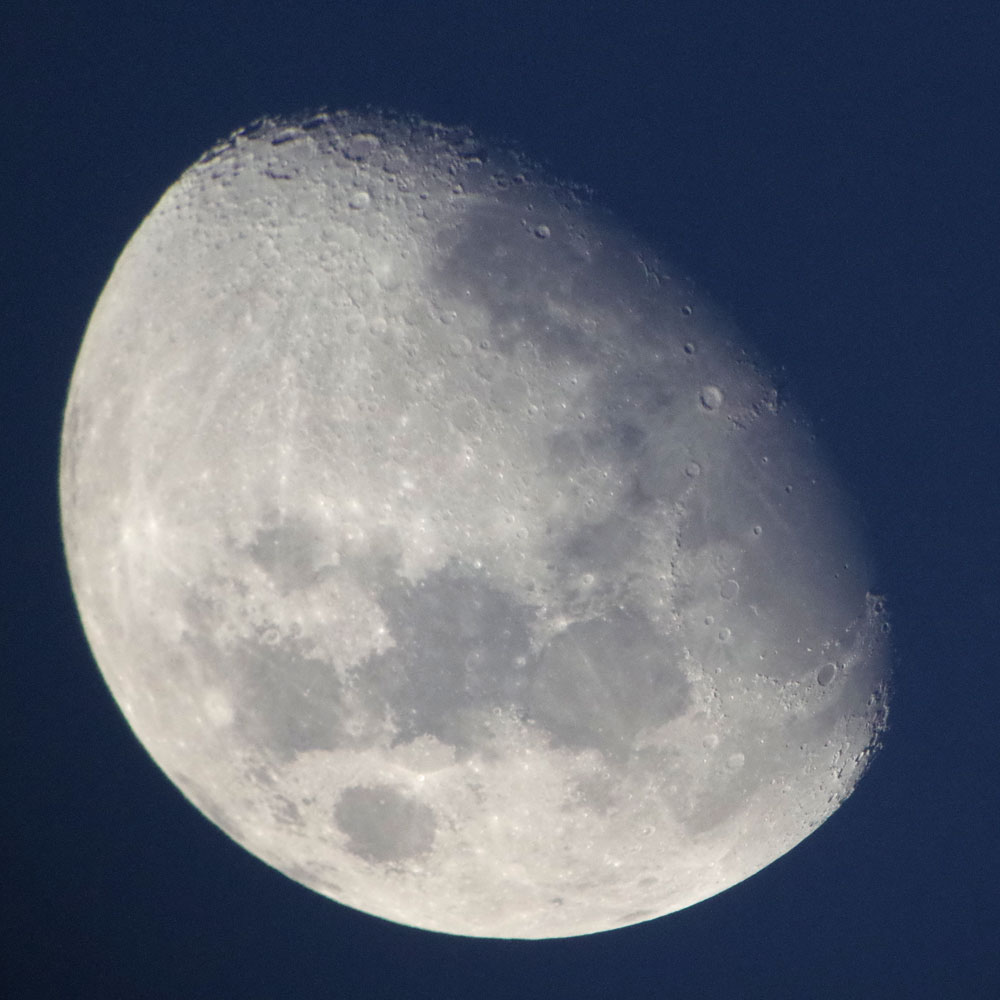 |
|
16 mm eyepiece (approx. 47 x) - 2000 pixels version |
16 mm eyepiece (approx. 47 x) - 2000 pixels version |
|
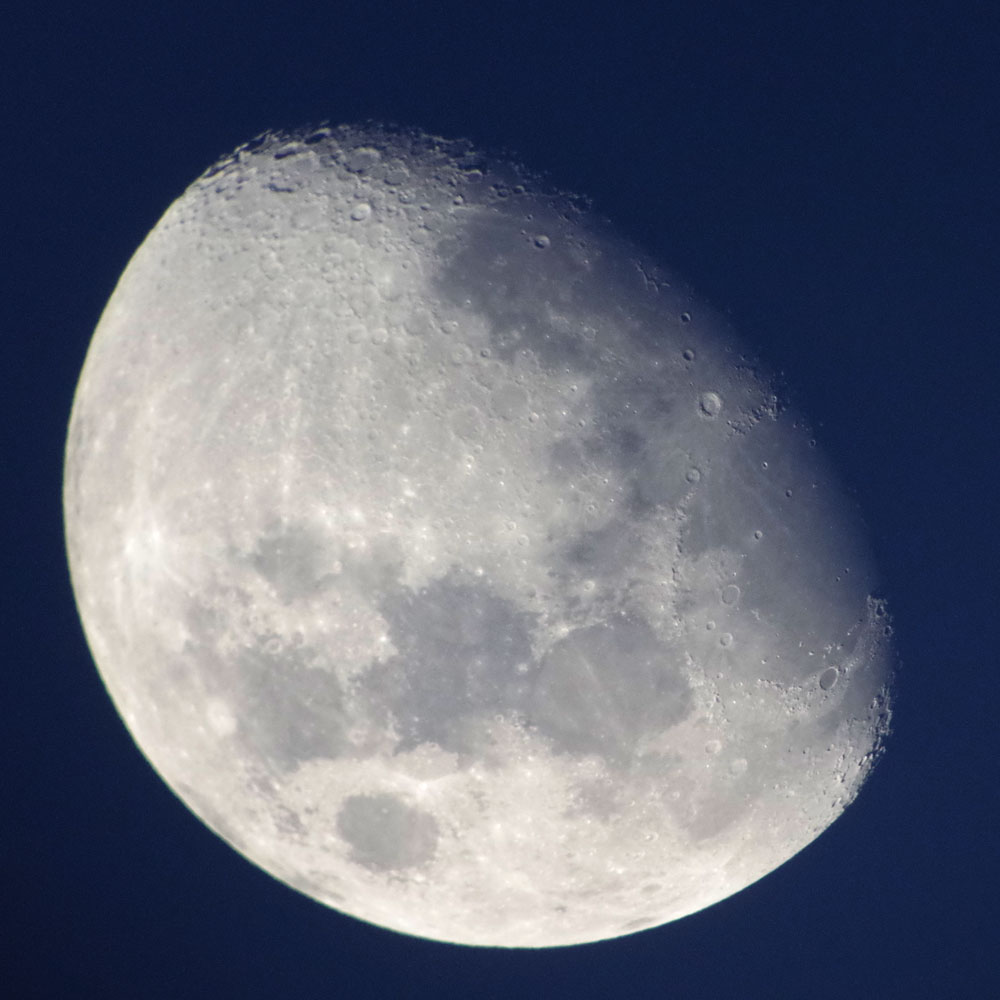 |
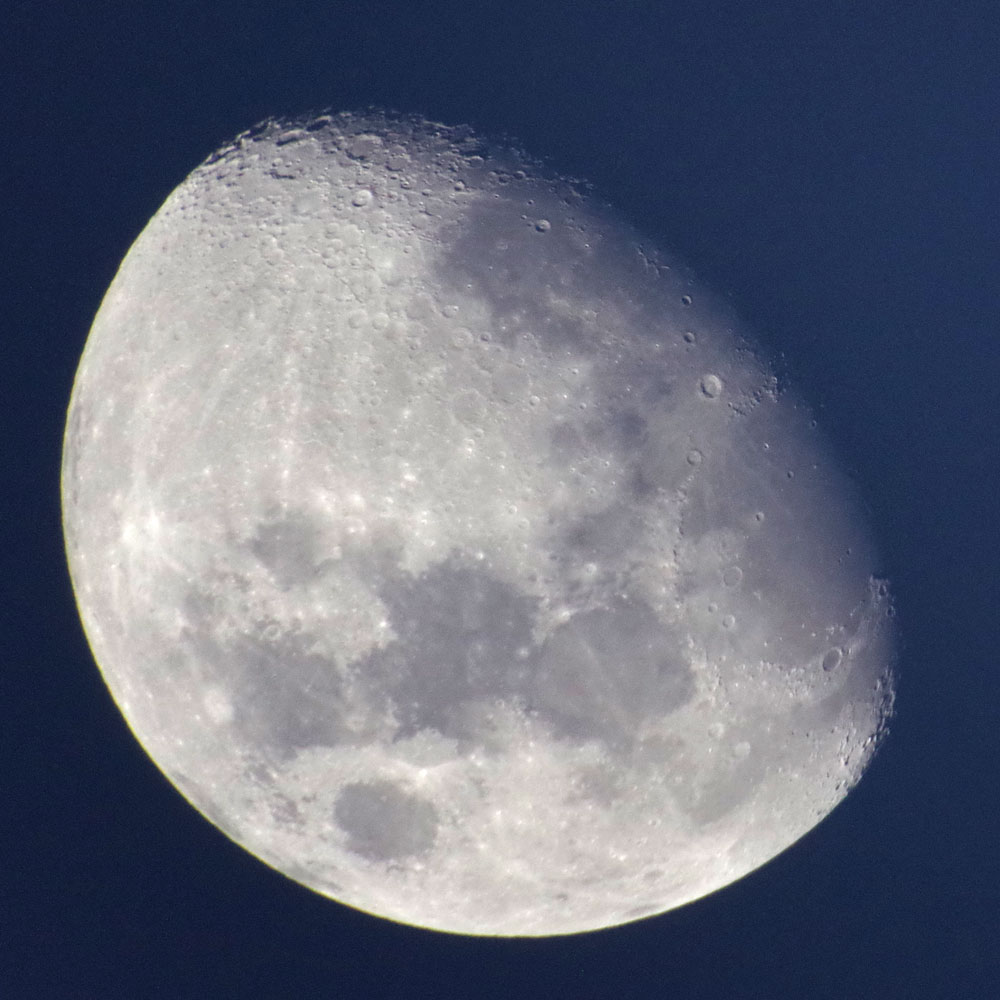 |
|
16 mm eyepiece (approx. 47 x) - 2000 pixels version |
16 mm eyepiece (approx. 47 x) - 2000 pixels version |
|
Photos with Atik Infinity
Photos taken with Sky-Watcher Explorer 150PDS (December 31, 2017), 600 x 600 section with 1:1 pixels in the large version:
Photos taken with Sky-Watcher Explorer 150PDS (February 12, 2018), 600 x 600 section with 1:1 pixels in the large version:
Experiences
So far, however, my impressions with respect to the Sky-Watcher Explorer 150PDS are very positive. I particularly like the dual speed focuser, which makes focusing much easier for me. And this scope is a lot easier to handle than the bulkier and heavier 8" GSO GSD 680 telescope. While the GSD 680 pushed me to the limits with its weight, I can carry and handle the Explorer PDS150 still fairly easily. At the beginning, however, I had difficulties with attaching the Vixen rail to the base - I needed three hands for this, or help from another person. In the meantime, however, I can do this on my own.
Sky-Watcher Tube Explorer 150PDS on the Sky-Watcher Star Discovery AZ GoTo Mount
So far, I have observed a number of sky objects with the 150PDS and used it mostly on the Sky-Watcher Star Discovery AZ GoTo mount, on the one hand to gain experience with this combination (see here my experiences that I made so far with "overloading the mount with a 6" Newton tube"), but also because I did not have a suitable Dobsonian base anymore. The base of the Heritage P130 would (mostly) have worked for this tube, but I had given this telescope away in April 2017... In the course of time, however, I have gained more and more confidence in this "overloaded combination" and worry now less about the durability of the mount. At the beginning of February 2018, I even purchased a Celestron StarSense AutoAlign module for Sky-Watcher (mounts) to automate the alignment and save myself from having to "creep" under the viewfinder.
Further experiences with the Sky-Watcher Star Discovery AZ GoTo Mount can be found on page Sky-Watcher Star Discovery AZ GoTo Mount - First Experiences.
Comparisons
Initial Comparisons
I did a first quick & dirty comparison with the 8 "GSD 680 Dobsonian telescope using M 42/43 and M 35 as targets (about April 6, 2017). Since my eyepieces do not allow me to use both telescopes at exactly the same magnification, such a comparison is problematic, though. Overall and not surprising, the view in the GDS 680 seemed to be brighter and having more contrast to me, but the Explorer PDS150 was not bad either. Although I was decided to sell the GSD 680, because it was too heavy for me, this comparison made me a little bit uncertain again about this matter. But in the end, I parted from the GSD 680, as nice as the telescope was, and gave it to a dealer on sale or return to sell it for me (in the meantime, it was sold).
A few days later (April 9, 2017), I did a comparison with the 5" Heritage P130 Dobsonian telescope. Again, I was not able to operate the telescopes in parallel at exactly the same magnification. Overall and hardly surprising, the view was somewhat better in the PDS150 than in the P130, although I would not say that the differences were huge. On the whole, however, I could not see any advantages in owning both telescopes, although the P130 is certainly better suited to traveling. Therefore, I gave the P130 away to a friend in mid-April 2017.
Recent Comparisons
In mid-October 2019 (Oct 12-16), I compared a borrowed Sky-Watcher StarTravel 120/600 (120 mm refractor, ST120) with several of my telescopes, the Sky-Watcher Explorer 150PDS (6" Newton, 150PDS), the Sky-Watcher Skymax-127 (5" Maksutov-Cassegrain, SM127) and the Omegon Photography Scope 72/432 (72 mm ED refractor, PS72). In this test, I observed the wild duck cluster M 11 with all four telescopes. This test was won by the Explorer 150PDS, and I was able to confirm that the ranking in image quality coincided with the size of the "actual" aperture (considering the obstruction of the Skymax-127):
- 150PDS > ST120 > SM127 > PS72
At the end of December 2019, I made a small comparison of the Explorer 150PDS (6") with my new Celestron C8 (8") and the Sky-Watcher Skymax-127 (5"): I observed the following objects: M 15, M 35, M 42/43, M 45 (not all objects were observed with all telescopes). As expected, the C8 won this comparison, closely followed by the 150PDS, and the SM127 was somewhat behind the two larger telescopes.
All in all, these comparisons demonstrate that the size of the aperture is the essential criterion for the to be expected image quality. Nevertheless, there are, of course, further differences between the telescope types in terms of sharpness and contrast, but also in terms of typical image flaws (color fringes, coma, etc.).
A Walk Through My Eyepieces...
All My Eyepieces on the Moon
On January 1st, 2020, I tried all my eyepieces (from 4 mm UWA to 56 mm Plössl) and the Sky-Watcher Kit eyepieces (10 mm and 15 mm) on the Explorer 150PDS (on AZ4 mount). I came into focus with all eyepieces, but needed the included extension sleeve for the 2" eyepieces (because it is a photo Newton with a lot of backfocus...). My 1.25" eyepieces worked with the 2" to 1.25" adapter (without the 2" extension sleeve). When using the 2" eyepiece with long focal lengths, I saw the shadow of the secondary mirror, because it was not yet completely dark.
The Moon was my test object, which was almost half. With my 4 mm eyepiece, I also searched for identifiable small craters and, with the help of the Virtual Moon software, was finally able to identify the crater Piccolomini T (8 km in diameter) . When using the 4 mm eyepiece (187.5 x magnification), the image was already clearly darker (AP = 0.8).
By the way, the Sky-Watcher kit lenses did not do poorly in this comparison (I did not compare very intensively!). Only the small field of view of the 10 mm eyepiece was unpleasant. Nevertheless, it still captured the full moon (as does my 7 mm eyepiece, which however shows a larger field of view). The 25 mm kit eyepiece worked quite well, and I did not see any differences to the 24 mm TeleVue eyepiece at first go; with a little more effort, I would have surely found these. The 10 mm kit eyepiece does have a "tunnel vision", but compared to the TeleVue Delos 10 mm eyepiece, its image did not look poorly.
Selected eyepieces on some deep sky objects
On January 5, 2020, I set up the Explorer 150PDS after 9 o'clock to test my 2" eyepieces on it again, primarily using the Orion Nebula. Meanwhile, the moon was more than half, bright, and already quite disturbing. Nevertheless the Orion Nebula was quite well to see later, including its wings and the Trapezium. I used the following eyepieces:
- 56, 40, 35, 28, 24, 16, 10 mm - down to 28 mm inclusive, these were all 2" eyepieces
I started my observations with 56, 40, 35 and 28 mm 2" eyepieces, then continued with 24 mm, 16, and 10 mm 1.25" eyepieces. Later, I switched between eyepieces as needed.
The 56 mm eyepiece did not convince me. As a Plössl eyepiece, it had a "tunnel view", and the shadow of the secondary mirror could be seen, which was not the case with the other long focal length eyepieces this time. So did not include it in further observations.
At the beginning, my eyes were not really dark-adapted, which showed in the visibility of the Trapezium in the Orion Nebula: In the 40 mm eyepiece, the Trapezium was not visible at first, in the 35 mm eyepiece it appeared like a "star with ears", from 28 mm on, it was resolvable into stars. But later, when my eyes were better adapted to the darkness, I recognized the - tiny - Trapezium even in the 40 mm eyepiece without any problems!
I compared the 28 mm LET eyepiece (2", 56°) with my 24 mm TeleVue eyepiece, because both have the same true field of view. In the 28 mm eyepiece, the field of view was easier to oversee, but the trapezoid was easier to recognize in the 24 mm eyepiece - thanks to slightly higher magnification and a wider apparent field of view. In the end, my wife and I liked the 24 mm eyepiece better. So I will probably give the 28 mm eyepiece away in the case that I will sell the Explorer (it was an accessory of it).
The Trapezium was even better to see in the 16 mm and 10 mm eyepiece thanks to the higher magnification. All in all, the Orion Nebula was most impressive in the 10 mm eyepiece! Later, when my eyes were better adapted to the darkness, Trapezium and wings were best seen in this eyepiece (but even in the 40 mm eyepiece I was able to recognize the - tiny - trapezoid without any problems!)
For exploring the "Rich-field" capabilities of the Explorer 150PDS, I wandered a bit around the sky with the 40mm and 35mm eyepieces, even though this was not the best day for such an activity because of the bright moon. I recognized a beautiful chain of stars above Gemini (or wherever...), which reminded me of Kemble's cascade.
The term "Rich-field" includes large sky objects. That is why I accessed M 45 (Pleiades) and Mel 25 (Hyades). The Pleiades appeared most beautiful in the 40 mm eyepiece, because this offers the largest field of view (also used: 35, 28 mm). The Hyades visited afterwards were not that impressive for me, but they are already too large even for the field of view of the 40 mm eyepiece (which is 3.6°).
Finally, I searched for the open star cluster M 35 (Gemini) and found it only with difficulty. It was very beautiful in the 10 mm eyepiece! By the way, from time to time I returned to the Orion Nebula...
All in all, the Explorer 150PDS convinced me with all eyepieces except for the 56 mm eyepiece (but that was because of the eyepiece and not the telescope)! Rich-field observations seem to be feasible with the Explorer 150PDS, although this was not the day for it because of the bright moon. And, of course, with a maximum magnification of 225 x, it is also suitable for small sky objects like globular clusters and planetary nebulae (I tried those in the past). The central European sky rarely allows higher magnifications anyway. On the moon, however, you can use higher magnifications with the Explorer 150PDS to explore surface details. All this leads me to consider the Explorer 150PDS as a really " universal telescope".
Astrophotography
The Sky-Watcher Explorer 150PDS tube already shows its suitability for astrophotography in its name: "P" means "designed for astrophotography" (that is, it has sufficient backfocus) and "DS" means "Dual Speed," which refers to a 2" Crayford focuser with 1:10 dual speed transmission and the ability to carry up to 2 kg. Accordingly, I got into focus with the Atik Infinity camera at this tube without any problems, and the first results are quite OK, even though I am sure that much better results are possible. See the examples above.
Astrophotography with a camera held or attached to the eyepiece (1:50-method, projection method) is of course also possible (moon, planets, sun with solar filter), as shown in the examples above. However, holding the camera with your hand to the eyepiece often results in vignetting and local blurring. Photography of deep sky objects is not possible this way because of the long exposure times that are required.
Conclusions
The Explorer 150PDS Newton tube delivered the best results of any of my current telescopes ("delivered" because in November 2021 I purchased a Celestron C8 tube that seems to be a little bit better to me...). Nevertheless, I have used my Explorer tube comparatively rarely, because I often preferred my smaller telescopes, which can be set up faster when I do not use my GoTo mount - whereas I can operate the Explorer 150PDS only on my GoTo mount because of its weight.
I would not take the Explorer 150PDS tube with me on vacation because of its weight and size, apart from that the larger GoTo mount and other accessories would also have to be included. But this may not deter other star friends, because all in all the equipment is still manageable... And of course you can quickly pack everything into your car and transport it to a more distant observation place.
The Explorer 150PDS has proven to be an ideal partner for my Atik Infinity camera, even though I did fully exploit this combination and rarely used it later.
With respect to the observation of DSO, I also did not fully exploit the Explorer 150PDS, but I was able to make very nice observations visually at, for example, globular star clusters, open star clusters, and the Orion Nebula (see also the list above). Rich-field observations seem to be feasible with the Explorer 150PDS, particularly with 2" eyepieces with a long focal length. And, of course, with a maximum magnification of 225 x, it is also suitable for small sky objects like globular star clusters and planetary nebulae. The central European sky rarely allows higher magnifications anyway. On the moon, however, you can use higher magnifications with the Explorer 150PDS to explore surface details. All this leads me to consider the Explorer 150PDS as a really " universal telescope".
Nevertheless, in November 2019, I bought a Celestron C8 tube because I wanted to own an 8" tube, which means more aperture. So I sold my 6" Sky-Watcher Explorer 150PDS Newtonian tube in mid-January 2020. For this reason, I can no longer report any more experiences with this instrument.
Links
- Sky-Watcher Company Website, USA: www.skywatchertelescope.com
Explorer 150PDS (BKP 150 DS) page on Sky-Watcher Website: www.skywatcher.com/product/bkp-150-ds/ - Pages from German Distributors for the Sky-Watcher Explorer 150PDS:
- Teleskop-Spezialisten (here I bought the tube): www.teleskop-spezialisten.de/shop/Newton/150mm-6-Zoll/Skywatcher-Explorer-150PDS-150mm-750mm-f-5-6-Zoll-Newton-Teleskop::612.html (in German) - www.teleskop-spezialisten.de/shop/Newtonian/150mm-6-inch/::612.html?language=en (in English)
- Astroshop: www.astroshop.de/skywatcher-teleskop-n-150-750-pds-explorer-bd-ota/p,19163#tab_bar_1_select (in German) - www.astroshop.eu/skywatcher-telescope-n-150-750-pds-explorer-bd-ota/p,19163 (in English)
- Teleskop Service: www.teleskop-express.de/shop/product_info.php/info/p3886_Skywatcher-Explorer-150PDS---6--f-5-Newton---2--Dual-Speed.html (in German) - www.teleskop-express.de/shop/product_info.php/language/en/info/p3886_Skywatcher-Explorer-150PDS---6--f-5-Newton---2--Dual-Speed.html (in English)
- See also my page offering Astronomy Links.
Appendix: Data for Sky-Watcher Newton Telescope Explorer 150PDS
Technical Data
| Telescope: Sky-Watcher | Explorer 150PDS |
| Optical Design | Newton (Parabolic) |
| Primary Mirror Diameter | 150 mm (6") |
| Focal Length, Focal Ratio | 750 mm, f/5 |
| Resolving Power (arc secs) | 0.77" |
| Limiting Visual Stellar Magnitude | 12.7 mag |
| Light Gathering Power | 459.2 |
| Maximum Practical Visual Power | ca. 225 x (300 x) |
| Optical Tube Dimensions (diam. x length) | 18.2 cm x 69 cm / 18 cm x 68 cm* |
| Net Weight Basis | -- |
| Net Weight Optical Tube | 5.0/6.0 kg / 5.5 kg* |
| Net Weight Complete | -- |
Dark Blue: Telescopes that I still own; italic and dark red: telescopes that I owned; black: for comparison; *) own measurement; **) corrected values
See also the table of data for all of my telescopes (and a few more...)
Observation-Relevant Data (in Comparison with other Newtonian Tubes)
| Telescope | Focal |
Aperture (mm) |
Focal Ratio |
Light Gathering Power |
Maximum+ |
Minimum* |
Maximum* |
Minimum+ |
|||||
Usable Magnification |
Usable Focal
Length of Eyepiece (mm) |
||||||||||||
Factor/Exit Pupil (mm) > |
Manuf. |
1.5 |
2 |
6.5 |
7 |
6.5 |
7 |
1.5 |
2 |
||||
| Heritage 100P | 400 |
100 |
4 |
204 |
150 |
200 |
15.38 |
14.29 |
26.0 |
28.0 |
2.7 |
2.0 |
|
| Heritage P130 | 650 |
130 |
5 |
345 |
220 |
195 |
260 |
20.00 |
18.57 |
32.5 |
35.0 |
3.3 |
2.5 |
| Explorer 150PDS/Dobson 6" | 750 |
150
|
5 |
459 |
225 |
300 |
23.08 |
21.43 |
32.5 |
35.0 |
3.3 |
2.5 |
|
| Dobson/Newton 6" | 900 |
150 |
6 |
459 |
225 |
300 |
23.08 |
21.43 |
39.0 |
42.0 |
4.0 |
3.0 |
|
| Dobson/Newton 6" | 1200 |
150 |
8 |
459 |
225 |
300 |
23.08 |
21.43 |
52.0 |
56.0 |
5.3 |
4.0 |
|
| Dobson/Newton 8" | 1200 |
200 |
6 |
816 |
300 |
400 |
30.77 |
28.57 |
39.0 |
42.0 |
4.0 |
3.0 |
|
| Dobson/Newton 10" | 1270 |
254 |
5 |
1317 |
600 |
381 |
500 |
39.08 |
36.29 |
32.5 |
35.0 |
3.3 |
2.5 |
*) Calculated for an exit pupil of 6.5 mm and 7 mm
+) Factor 1.5 or 2 for Dobsonian/Newtonian telescopes; in general, the lower
value of 1.5 is used for Newtonian telescopes; if the manufacturer specified
a different magnification, it is also listed (some manufacturer provide considerably
higher numbers...).
Visual Power (Magnification) and Other Data for Different Focal Lengths of Eyepieces (Mostly My Eyepieces)
Note: These tables include the StarTravel 120 refractor, a TSWA32 eyepiece (2", 32 mm focal length, 70° viewing angle) that I borrowed together with the StarTravel 120, a 18 mm eyepiece (2", 82° viewing angle), a 38 mm eyepiece (2", 70° viewing angle), and a 56 mm eyepiece (2", 52° viewing angle).
| Telescope | Further Data |
Focal Length of Eyepiece (mm) |
||||||||||||
| Magnification | ||||||||||||||
Focal Length of Telescope (mm) |
4 |
7 |
10 |
16 |
18 |
24 |
28 |
32 |
32 |
35 |
38 |
40 |
56 |
|
| PS 72/432 | 432 |
108.00 |
61.71 |
43.20 |
27.00 |
24.00 |
18.00 |
15.43 |
13.50 |
13.50 |
12.34 |
11.37 |
10.80 |
7.71 |
| ST120 | 600 |
150.00 |
85.71 |
60.00 |
37.50 |
33.33 |
25.00 |
21.43 |
18.75 |
18.75 |
17.14 |
15.79 |
15.00 |
10.71 |
| 150PDS | 750 |
187.50 |
107.14 |
75.00 |
46.88 |
41.67 |
31.25 |
26.79 |
23.44 |
23.44 |
21.43 |
19.74 |
18.75 |
13.39 |
| SM127 | 1500 |
375.00 |
214.29 |
150.00 |
93.75 |
--- |
62.50 |
--- |
46.88 |
--- |
--- |
--- |
--- |
--- |
| C8 | 2032 |
508.00 |
290.29 |
203.20 |
127.00 |
112.89 |
84.67 |
72.57 |
63.50 |
63.50 |
58.06 |
53.47 |
50.80 |
36.29 |
| C8 (red.) | 1280 |
320.00 |
182.86 |
128.00 |
80.00 |
--- |
53.33 |
--- |
40.00 |
--- |
--- |
--- |
--- |
--- |
| True Field of View (°) | ||||||||||||||
Apparent Field
of View (°) > |
82 |
82 |
72 |
82 |
82 |
65 |
56 |
52 |
70 |
69 |
70 |
68 |
52 |
|
Focal Length of Telescope (mm) |
4 |
7 |
10 |
16 |
18 |
24 |
28 |
32 |
32 |
35 |
38 |
40 |
56 |
|
| PS 72/432 | 432 |
0.76 |
1.33 |
1.67 |
3.04 |
3.42 |
3.61 |
3.63 |
3.85 |
5.19 |
5.59 |
6.16 |
6.30 |
6.74 |
| ST120 | 600 |
0.55 |
0.96 |
1.20 |
2.19 |
2.46 |
2.60 |
2.61 |
2.77 |
3.73 |
4.03 |
4.43 |
4.53 |
4.85 |
| 150PDS | 750 |
0.44 |
0.77 |
0.96 |
1.75 |
1.97 |
2.08 |
2.09 |
2.22 |
2.99 |
3.22 |
3.55 |
3.63 |
3.88 |
| SM127 | 1500 |
0.22 |
0.38 |
0.48 |
0.87 |
--- |
1.04 |
--- |
1.11 |
--- |
--- |
--- |
--- |
--- |
| C8 | 2032 |
0.16 |
0.28 |
0.35 |
0.65 |
0.73 |
0.77 |
0.77 |
0.82 |
1.10 |
1.19 |
1.31 |
1.34 |
1.43 |
| C8 (Red.) | 1280 |
0.26 |
0.45 |
0.63 |
1.03 |
--- |
1.22 |
--- |
1.30 |
--- |
--- |
--- |
--- |
--- |
| Exit Pupil (mm) | ||||||||||||||
Focal Ratio |
4 |
7 |
10 |
16 |
18 |
24 |
28 |
32 |
32 |
35 |
38 |
40 |
56 |
|
| PS 72/432 | 6 |
0.67 |
1.17 |
1.67 |
2.67 |
3.00 |
4.00 |
4.67 |
5.33 |
5.33 |
5.83 |
6.33 |
6.67 |
9.33 |
| ST120 | 5 |
0.80 |
1.40 |
2.00 |
3.20 |
3.60 |
4.80 |
5.60 |
6.40 |
6.40 |
7.00 |
7.60 |
8.00 |
11.20 |
| 150PDS | 5 |
0.80 |
1.40 |
2.00 |
3.20 |
3.60 |
4.80 |
5.60 |
6.40 |
6.40 |
7.00 |
7.60 |
8.00 |
11.20 |
| SM127 | 11.81 |
0.34 |
0.59 |
0.85 |
1.35 |
--- |
2.03 |
--- |
2.71 |
--- |
--- |
--- |
--- |
--- |
| C8 | 10 |
0.40 |
0.70 |
1.00 |
1.60 |
1.80 |
2.40 |
2.80 |
3.20 |
3.20 |
3.50 |
3.80 |
4.00 |
5.60 |
| C8 (red.) | 6.3 |
0.63 |
1.11 |
1.59 |
2.54 |
--- |
3.81 |
--- |
5.08 |
--- |
--- |
--- |
--- |
--- |
Blue: Equipment that I borrowed for comparison purposes; italic 2" eyepiece
Magnification: Yellow: low (30-50 x); magenta: medium
(80-100 x); violet: high (150-200 x - and more); red: beyond
maximum usable magnification.
Exit pupil: Values in magenta cells are
either too small (< 1 mm) or too large (> 6.4/7 mm); yellow background:
best for galaxies (about 2-3 mm).
Recommendations for the Focal Lengths of Eyepieces for Explorer 150PDS (Following My Recommendations and Those of Others)
| Criteria | Exit Pupil |
Focal Length of Eyepiece |
|||||
| Category | Application Area | from...to |
Calculated |
On the Market |
Examples |
Proposals |
|
| Maximum FOV | Search | 7 |
10 |
35-50 |
35-56* |
35, 38, 40, 56* |
35, 40 |
| Minimum Magnification / Large FOV | Overview, large-area nebulae | 4.5 |
6.5 |
22.5-33.5 |
20-32* |
25, 26, 28, 30, 32* |
25, 26, 28, 32 |
| Normal Magnification | Large-area, faint nebulae; nebulae, open star clusters | 3.5 |
4 |
17-20 |
16-20* |
16...20 |
16, 18, 20 |
| Best for many objects, e.g. for most galaxies, and mid-size DSO | 2 |
3 |
10-15 |
10-15 |
10, 12, 15 |
10, 12, 15 |
|
| Maximum Magnification / Maximum Resolution | "Normal" upper magnification limit; globular star clusters | 1 |
1.5 |
5-7.5 |
5-7.5 |
5, 6, 7 |
5, 6, 7 |
| Maximum perceptibility of small, low-contrast details; planetary nebulae, small galaxies; maximum magnification for moon and planets |
0.6 |
0.8 |
3.0-4.0 |
3-4 |
4 |
3.5, 4 |
|
| Separation of narrow double stars, small planetary nebulae; perception of faintest details |
0.4 |
0.5 |
2.0-2.5 |
2-2.5 |
2.5 |
2.5 |
|
*) Partly available as 2" eyepiece; **) typically no suitable 1.25" eyepieces available; problems with viewing at 40 mm; italic: not possible; red: magnification too high; blue: commercial focal lengths
Appendix 2: Sky-Watcher Explorer 150PDS Report (for Teleskop-Spezialisten)
At the beginning of April 2017, I purchased the 6" Newton tube Skywatcher
Explorer-150PDS* as a replacement for the 8" Dobson telescope GSO GSD
680, which is a very good telescope, but was too heavy for me. Thus the Explorer
150PDS was first the final station on a longer journey from 10" over 8" to
finally a modest 6" aperture*! Normally, however, such journeys run in
reverse, namely in the direction of larger apertures...
*) In November 2019 I took once more a step in the direction of greater apertures
with purchasing a Celestron C8.
All in all, I have not yet gained enough experience with the Sky-Watcher Explorer 150PDS tube to be able to make a well-founded judgement on it. Because mostly I preferred my small telescopes to the Explorer, although it showed the sky objects best of all my telescopes. But my impressions are very positive so far. I have learned to appreciate the focuser with 1:10 fine adjustment - it makes focusing much more pleasant. And this telescope is much easier for me to handle and carry than the larger and heavier 8" GSD 680 telescope. While the GSD 680 showed me my physical limits because of its weight, I can still handle the Explorer PDS reasonably well. Admittedly, it was a bit difficult for me at first to attach the Vixen rail to my mount because I actually would have needed three hands or the help of someone else. But now I am able to mount the tube on my own.
So far, I have visited the following sky objects with the Sky-Watcher Explorer 150PDS:
- Moon, Jupiter, Saturn
- Without Goto (April 2017): M 35 and M 42/43
- With GoTo (May 2017): M 3, M 5, M 13, M 35, M 44, M 49, M 51, M 53, M 64, M 65/66, M 67, M 81/82, M 87, M 92, M 94, M 96, M 104, M 106
- With GoTo (May 2019): M 35, M 36, M 37, M 38, M 44
- With Atik Infinity (beginning of 2018): M 15, M 27, M 35, M 36, M 37, M 38, M 42/43, M 56 , M 57, M 71
- With GoTo (August 2019): M 11, M 13, M 27, M 57, M 92
Sky-Watcher Tubus Explorer 150PDS on the Sky-Watcher Star Discovery AZ GoTo Mount
When I bought the Explorer 150PDS, I hoped that the 6" tube could also be used on the Sky-Watcher Star Discovery AZ GoTo mount, so to speak as the "maximum possible aperture". This would have allowed me to use all my current telescope tubes on the GoTo mount, which carries a maximum of 5kg. The Explorer's weight was indicated at different dealers as 5 kg, after the purchase I also found 6 kg on the Internet. My own measurements resulted in a weight of 5.5 kg for the Explorer tube - plus viewfinder and eyepiece. At first I was curious whether this combination would really work in the long run, and I consulted Mr. Kloß, who provides instructions on how to adapt the mount to higher loads. Over time, I have gained more and more confidence in this "overloaded combination" and am now less concerned about the durability of the mount.
Because of its length, which is rather short for a 6" tube (because it has f/5), the tube can also bump against the legs of the tripod of the mount. Maybe this happened to me sometimes when the mount had problems with moving the tube around - but I did not realize in the dark that this was the issue...
Astrophotography (Fast Photography)
The Sky-Watcher Explorer 150PDS tube already bears its suitability for astrophotography in its name: "P" means "designed for astrophotography" (sufficient "backfocus") and "DS" means "dual speed", which refers to its 2" Crayford focusing unit with 1:10 reduction, which should be able to carry up to 2 kg. A starfriend was using a similar tube on a parallactic mount, and he took impressive DSO photos with his SLR camera. However, I do not want to invest so much effort, and in November 2017 I supported in the eVscope project, which is rather classified as "video astronomy". However, the eVscope will not arrive before February 2020. In order to bridge this time span and get a taste of "fast astronomy photography," I bought a used Atik Infinity camera at the end of 2017. With this camera I can get into focus with the Explorer 150PDS tube without any problems, and the first results with DSO are at least impressive, even if better results are certainly possible. A photo of the Orion Nebula M 42/43 is the most beautiful one that I took!
Astrophotography with a camera held or attached to the eyepiece (1:50 method, projection method) is, of course, also possible (moon, planets, sun with solar filter), and I also tried this with the Explorer 150PDS tube. Because of the rather short focal length of 750 mm, my Maksutov Cassegrain tubes are preferable for this application.
Conclusions
The Explorer 150PDS Newton tube delivered the best results of any of my current telescopes. "Delivered" because I recently purchased a Celestron C8 tube that I have not been able to test yet... Nevertheless I have used my Explorer tube comparatively rarely, because I often preferred my smaller telescopes, which can be set up faster when I do not use my GoTo mount - whereas I can operate the Explorer 150PDS only on my GoTo mount because of its weight.
I would not take the Explorer 150PDS tube with me on vacation because of its weight and size, apart from that the larger GoTo mount and other accessories would also have to be included. But this may not deter other star friends, because all in all the equipment is still manageable... And of course you can quickly pack everything into your car and transport it to a more distant observation place.
The Explorer 150PDS has proven to be an ideal partner for my Atik Infinity camera, even though I have not yet fully exploited this combination and have rarely used it lately.
With respect to the observation of DSO I also have not fully exploited the Explorer 150PDS yet, but I was able to make very nice observations visually at, for example, globular star clusters, open star clusters, and the Orion Nebula (see also the list above).
| 21.11.2024 |

